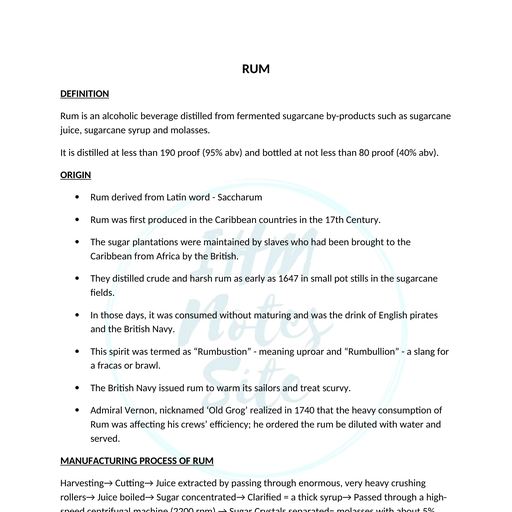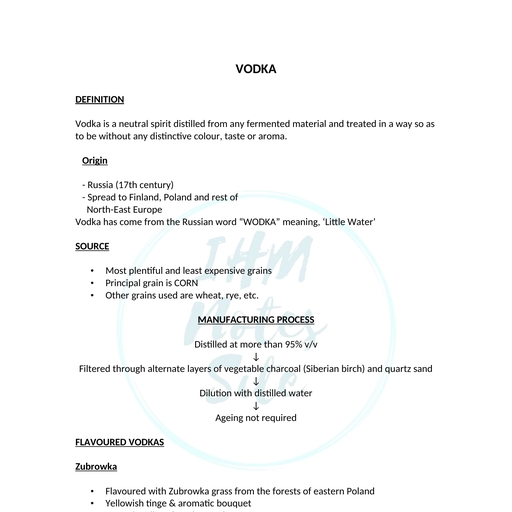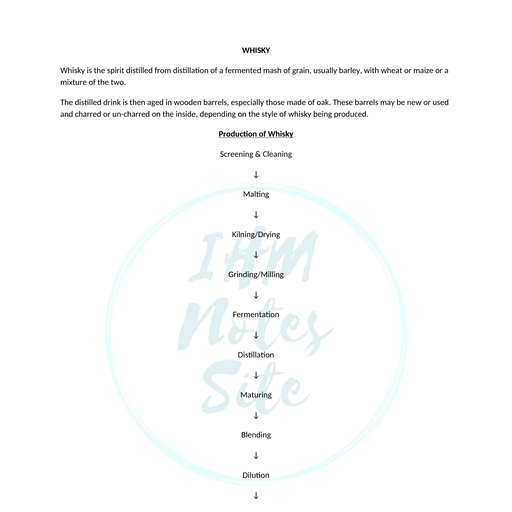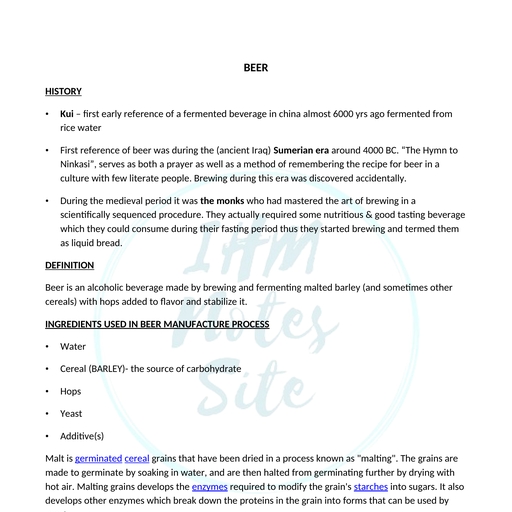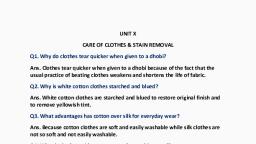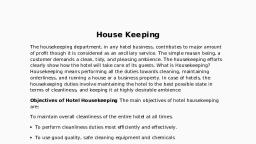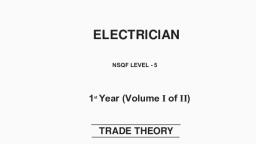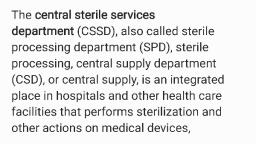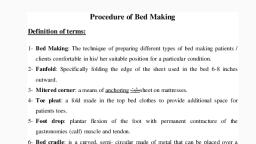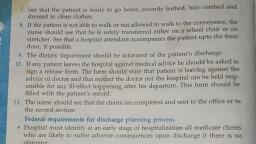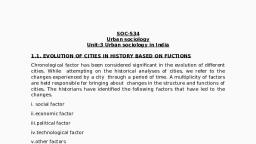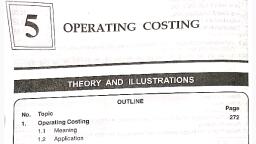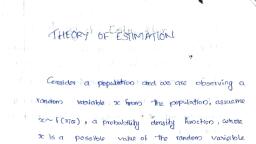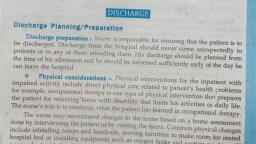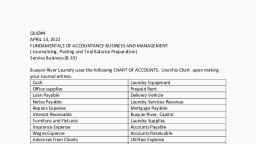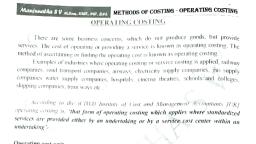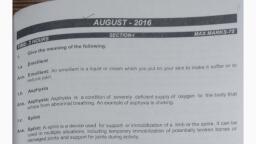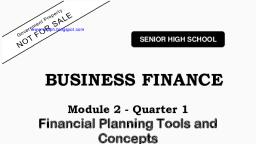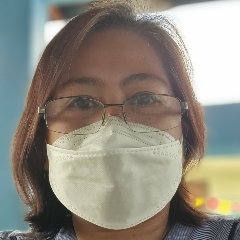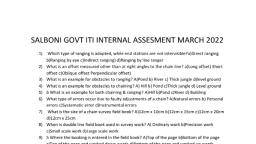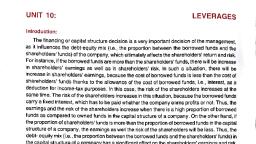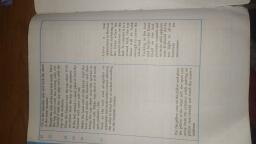Page 1 :
2nd year Accommodation Operation, ACCOMMODATION OPERATIONS, 3RD/4TH SEMESTER, Linen Room, The linen room is the centre-stage for the supporting role that the Housekeeping Department, plays in the hotel. Most linen rooms are centralized and act as a storage point and, distribution centre for clean linen. Usually, a par stock is maintained on each floor or at each, unit to suffice immediate requirements., The word linen is meant to refer to those fabrics, made from the fibre derived from the stem, of the flax plant. However in common terms, the word linen is u referred to a wide variety of, fabrics, used for domestic purposes., The word linen is meant to refer to those fabrics, made from the fibre derived from the stem, of the flax plant. However, in common terms, the word linen is used to refer to a wide variety, of fabrics, used for domestic purposes., a) Centralised linen room, Centralised system for storage & distribution of linen from one central point called, centralised Linen Room. In centralised distribution all the linen are issued from the linen, room and complete charge is taken by the linen room supervisor. Linen room supervisor, may issue fresh linens & holds the attendant responsible for returning the exact number of, linen as per issue i.e. one to one basis small hotels., SYSTEM SATISFACTORY FOR SMALL HOTELS., NO FLOOR PANTRY, b) Decentralised linen room, In decentralised all clean linen are stocked or placed in floor pantry for replacements. The, floor pantry stocks sufficient linen to serve the number of rooms. It is a good method for, large hotels where the maid does not need to go to the linen room for small issue, , Page 1
Page 2 :
2nd year Accommodation Operation, THE LINEN CYCLE, Collect linen from the floor pantry, , Exchange clean linen for dirty at the point of use, , Sort, count and bag soiled linen, , Transportation to central collection point, , Linen Room, Count, record, and despatch, , Laundry, (OPL), , Laundry, (Off-Premises), Check and Inspect, , Mending, if required, , Condemn, , Replace, , Storage with a rest period on the shelf, for linen in use, , Issuing to units, , Page 2
Page 3 :
2nd year Accommodation Operation, , ACTIVITIES OF LINEN ROOM, 1., Collection & transportation, Collection From different departments, Transportationfrom Floor pantryTo Linen Room, This is facilitated through chutes, canvas bags, trolleys, collapsible wire carts, skips. It is an, essential activity when laundry services are on contract. Guest laundry may also be collected, and billing and marking undertaken, should the laundry be off-premises., It is an essential activity when laundry services are on contract., Guest laundry may also be collected and billing and marking undertaken, should the laundry, be off-premises., Laundry Skip it is an elasticized net bag used to carry laundry, Linen Chute it is a vertical tube like structure from which soiled linen are thrown straight, to laundry from floor pantries, 2., , , , , 3., , , , , 4., , , , , , , 5., , 6., , Sorting & Counting, Sorting is carried out primarily to make counting possible as well as for streamlining, laundry procedures., Linen is counted in order to make a record so that issuing to departments may be, accurate and it is possible to tally the exchange of linen between the linen room and, the laundry and a basis for billing exists., Packaging, Soiled linens are packed in hampers after sorting to avoid mix-ups and to prevent, linen damage. Linens requiring repairs, or heavily soiled are put into different bags, colour coded respectively, Linen should be properly arranged in trolleys as to avoid damages. Linen edges, should not drag on the floor, Dispatch, Dispatch of soiled linen to laundry after sorting and counting & packaging., In case of commercial laundry the linens are dispatched outside for laundry or the, hotel also has its own laundry for washing linens., Generally dispatch time is between 3 to 5 pm after servicing the room., A list of soiled linen is sent to laundry along with dirty linen. A duplicate copy is, kept in the linen room (information like date, time, items, number of soiled linen and, signature), , , , Deliveries, Clean linen is delivered in the morning hours and evening deliveries are usually for, guest laundry., , , , Checking & inspection, After receiving linen from laundry checking the quantity to ensure that the amount, of laundered linen tallies amount of soiled linen items sent., Page 3
Page 4 :
2nd year Accommodation Operation, , , Inspection of quality of wash i.e. stains & dirt removed, no damages, no loss of, shape or colour, no blue streaks, or patches from optional brighter, properly ironed., Note: - it is also important because we need to check that articles belonging to other, hotel have been in advertently delivered, 7., Storage, Linen room storage depends on the size of the hotel, frequency of wash, change, type, of operation, linen coverage (par), storage should have good space, shelves clean &, safety factors being attacked by pests. Should be well ventilated and inaccessible to, pests, STORAGE OF LINEN, Constructed as to eliminate the possibility of damage by insect., Room must be well ventilated, cool & dry, Steam pipes, water pipes should not run through linen room as it may create, dampness., Racks, shelves should be properly designed to avoid rust, white ants, & pests, Last shelf of the rack should be at least 6” above the floor, so that linens do not soil, up during floor cleaning, Room should have 1 entry/exit for security purpose, Room accessible to all staff of the hotel, Periodical pest control should be practised, Arrange linen by size ie. heavy on bottom and lighter on top as to maintain balance, Small items should be kept in cupboard, Soiled linen should be put in separate hampers so to avoid mixing., Woollen items should be washed or dry cleaned before storage. They should be, wrapped & sealed in air- tight plastic foil e.g. :- Blankets, For long time storage, linen should be wrapped in plastic foil to preserve colour, Always follow FIFO, Linen should be stored and stacked with folds outwards for easy issue of items., Linen should be exchanged on one to one basis., 8., , Distribution to unit, Clean for dirty/ Fresh for soiled/ one on one basis, Soiled linen Clean linen, Topping up Dirty linen is dispatched down the linen chute in laundry & floor stock, is made up later in the day by houseman., , , , , , , , Collection of linen from different rooms to the floor pantry, Floor supervisor, checks, counts, Enters in “room linen control sheet”, Soiled linen send to linen room {hampers, linen chutes, canvas trolleys}, 2 copies of “RLCS” send to linen room with soiled linen, Linen supervisor receives, record verifies, stamps “received”, 1 copy RLCS , 2 copy RLCS , , Floor Supervisor, Linen Supervisor, , Against 2 RLCS Fresh Linens is issued on one to one basis, Page 4
Page 5 :
2nd year Accommodation Operation, , Time:- ___________, Linens, Sent by Floor, , Room Linen Control Sheet, Date:-_____________, Received by, Sent to Floor, Balance, Laundry, , Pillow Slips, Bath Towel, Bed Sheets, Bath Mats, Face Towels, Hand Towels, Bed Cover, Mattress, Cover, Foot Mats, Signatures, , Floor Supervisor, , Laundry Supervisor Linen Supervisor Linen Supervisor, , Set Amount Dirty linen is collected frequently from the corridors by the spotter, from laundry and the floor linen, clean linen items are made up at set amount, quantity. Set of linen issued on daily basis., Requisition Requisition filled up by department is given to linen room for issue., 9., Monogramming, Monogramming- putting Name and Logo, Identification- in Case of an off- premises laundry, where linen of different, hotels may get mixed and in the hotel itself, where-in each department's linen, may be identified., Advertisement, Detecting Pilferage, Monogramming - Name and logo of the establishment is put onto the linen item for, identification , advertisement & discouraging pilferage. This can be stitched, slicked, (wax sticker), printed or embossed, Marking - Stamping is done for year and date on the new linen arrived. It also, indicates the size of the article and date of putting it into circulation. Done by the, linen room supervisor and it is said to be Quoting of linen. Done in many ways:a) Marking pen which become permanent when applied at 400°F, b) By heat seal machine, c) Hand or machine embroidery, d) Stitching labels or stickers which permanently stick to the fabric when applied with, hot iron, e) Marking is done on the right hand side of the linen item., Page 5
Page 6 :
2nd year Accommodation Operation, , 10., , Repairs & alterations, Linen items are repaired in the linen room (sewing room) in case of damages (wear, & tear, loose stitches, open stitches, loose buttons and can be stitched or darned., Discarded linen items are also converted into useful items called Cut Downs &, makeovers. Example- Damaged bed sheets can be converted into napkins, tray, linens, baby cot sheet, dusters etc., The discard linen is used as rags, dust sheets and if the condition is good they can be, converted and reused as “Cut Down” or “recycle item” for example:A., Bed sheets can be converted into pillow covers & baby cot linen, B., Table cloth into tray linen, C., Blankets to be used as padding for ironing boards, D., Condemned towels are used in staff cloak room, 11., Discards, Linen is said to be condemned or discard when it is not fit for use in the guest room, and so it is taken out of the circulation. It is discarded when it has worn out or is, damaged or torn or stained while handling by guest or staff. Linen can be condemned, at any of the following stages:a) By room attendants by collecting it on the floor, b) While sorting in the linen room., c) While inspecting it in the linen room or laundry, d) While collecting it by F&B personnel, All condemned items are taken out of circulation stamped and noted in the discard, register., Discard procedure, Identification of linen beyond state of repair or stain removal (may be done in, laundry, linen room during stock taking), Linen taken out of circulation and placed separately in laundry on daily basis, Discards done on monthly basis, Discards counted, sorted, Discards inspected by the EHK & a representative from accounts. Discarded items, are stamped as “condemned”, Fill discards register, LINEN-DISCARD REGISTER, LINEN, , DISCARD, , MONTH, , RATE, , TOTAL, , BED, SHEET, , 04, , Jan ‘14, , 1000/-, , 4000/-, , Page 6
Page 7 :
2nd year Accommodation Operation, , EHK {, , }, , Accounts {, , }, , Importance of linen discard, a), Old linen can be recycled into useful items, b), Helps to minimise hotel budget & avoid unnecessary wastage, c), Records are maintained in the stock book for discards which help to monitor &, detect pilferage, Prevention of damage of linen, a. Check for faulty linen., b. Keep light on inside, c. Keep the linen door closed when not in use, d. Keep small linen like face towel inside trolley, bags, e. Put restrictions on misuse. Always follow SOP set by EHK, f. Avoid excess use of bleach as it weakens the fabric, g. White fabrics should not be thrown on concrete floor as concrete stains are, impossible to remove, h. Damp linen should be dealt with care as to avoid any bad smell (wash & dry, immediately), i. Exchange linen only one to one basis, j. Do not drag the linen outside the trolley as it may get torn, 12., StocktakingPhysical counting of all linen items at frequent intervals to know the, actual stock of linen and to check on to losses, a stock register is updated accordingly, 13., Security Linen room should have only one entry/ exit to restrict the movement, and to prevent the misuse of linen. It should be a non- smoking zone (area), LAYOUT AND EQUIPMENT IN THE LINEN ROOM, , , , , , , , , , , , , , , , shelves both open and closed, hanging space, Reserve Stock storage, drop counter for exchange of linen (stable-type door), Trolleys for clean linen, soiled linen hampers, Linen keeper’s desk and storage space for records, telephone and computer, stepladder, washbasin, storage for materials required to clean the room, sink and drying rack (optional), iron and ironing board, area for accumulation of soiled linen, Page 7
Page 8 :
2nd year Accommodation Operation, area for receiving laundered linen, area for sorting and counting of linen, sewing section (Tailor room), work tables (with table tops in contrast to white), traffic lane to laundry, traffic lane to uniform room, , ESSENTIAL FEATURES OF LINEN ROOM, A., LOCATION, 1. Ideally be located in the basement., 2. Next to the laundry so that there is easy exchange of linen items., 3. Should be away from food production area such that to avoid different food odours to, settle over linen., 4. Linen room should be near to the service elevator and should face the executive, housekeeping office so that transportation of linen items is easy and executive, housekeeper can keep an eye on the staff., B., SPACE ALLOCATION, Ideal space allocated should be 6 sq ft per room. Space should be large enough so that all, the work is carried out without overcrowding., 1. Storage area, shelves should be designed using maximum utilisation of space, Shelves must be slotted for proper ventilation; they must be wooden or, metallic. If metallic should be painted and maintained so that they are rust, free. Wooden shelves should be painted for mildew and ants and termites., Depth of the shelves should be about 18” to 20” if against the wall and 38”to, 40” if shelf is accessible from both sides., The shelves can reach up the ceiling with 6” clearance at the bottom for easy, cleaning and saving it from pests like termites, rats and even from dampness., Shelves should be clearly marked for each type or article., Linen room should be subjected to pest control schedules. Linen items stored, for long time like blankets must have shelves with cover/ curtains., 2. Wash basin, Linen room have a wash basin and along with the soap and towels as most of the, articles dealt are white in colour and the staff must wash their hands before handling, the linen, 3. Ironing board Linen room should have an ironing board for minor finishing jobs, 4. Inspection table, Inspection table should be large enough to accommodate the freshly washed, linen items which need to be inspected after they come from laundry, The colour should be in contrast with linen since only then standards of linen, will be visible. Since the inspection table requires a lot of space underneath, these table areas can be utilised for storage of different types of linen items, 5. Soiled linen area, The soiled linen area should be close to the entrance and large enough and, large enough to accommodate all types of linen., There should be enough of space to sort out and count the linen and pack, Page 8
Page 9 :
2nd year Accommodation Operation, , , The floorings and the walls of the areas should be of a surface which does not, stain the day dry or wet soiled linen., A separate adjoining room should be for new linen items, 6. Supervisor desk, The supervisor desk should be located in such a way that he has good view of entire, linen room especially the transaction points. The desk should be designed having, suitable amount of drawers for storing different files and records used for linen, exchange purpose., 7. Exchange counter, It is normally a window without any grill and wide enough to pass bundles of, linen. The window is used to exchange linen-:, The area below this counter can be used to park trolleys for collecting dirty, linen when the counter is not in use it should be kept bottled, The opening hours of linen room varies from establishment to establishment, but generally it is 8am-5pm, The rule of clean for dirty is considered the best way of keeping control on, linen with regard to losses and careless use., C., ENTRY/ EXIT DOOR, Ideally, there should be only one entry/exit which must be 4 ft wide so that there is, easy movement of trolleys., D., SECURITY, 1. As linen room has large assets stored in, it is important that no authorised person, should be allowed access to linen room., 2. When linen room is closed the door should be always kept locked and the keys should, be deposited to the security. In case of emergency the door can be opened in presence, of security Manager, duty manager and housekeeping supervisor., E., FIRE SAFETY, Since the linen area has highly inflammable items, a small amount of negligence also can, cause huge losses. So the fire precaution point should be placed in such a way that they, are easily accessible at the time of such incidents. Hot water or steam pipes should never, run through the linen room., F., LIGHTING, 1. The linen room should be well lit, as it lies in the basement and so the amount of, natural light will be very little., 2. White lights are preferred to yellow or glaring lights, G., HEATING & VENTILATION, 1. Linen room should be free from humidity as it invites mildews, moulds & pests., 2. Ideal temperature of linen room should be 20°C, 3. Should have adequate ventilation provided by fresh air vents, H., FLOORS, 1. Should be even, smooth, non slippery, heavy duty floors so that these can take heavy, load of dragging trolleys, 2. Floors should not be noisy, 3. Floors should be free from dampness, 4. Floor should be preferably made up of kota stone., , Page 9
Page 10 :
2nd year Accommodation Operation, I., WALLS, 1. Walls should be light in colours, ideally white. They should be free from moisture,, cracks etc., 2. They should be easily cleaned i.e. if painted then it should be washable, SAMPLE LINEN ROOM LAYOUT, Shelves for new linen, area, , Shelves, , Racks, , Work Table, , Work Table, , Racks, , Tailor, Room, , EHK, OFFICE, , Linen, supervisor, , Collection, Area, , Exchange, Counter, with, laundry, , Control, Desk, , Exchange, counter, , Shelves, , Inspection table, , Ham, per, , Ham, per, , Hamp, er, , One entry /exit, , PURCHASE SPECIFICATION/SELECTION CRITERIA FOR LINEN, 1., Value for money, It includes the cost of buying linens & maintaining one mainly prefers blends as they are, easier to use for longer time & maintains easily. Generally 65% cotton and 35% blends are, considered ideal. E.g. silk, wool needs to be maintained in case of laundering i.e. dry clean, 2., Type of establishment, 5 star hotels prefer poly cotton while 5 star deluxe hotels go for silk or Egyptian cotton. A, lower star hotel or a guest house goes for even a cheaper type of linen with less abrasion, resistance since the frequency of change of linen is maximum once a day., 3., Durability of fabric, The fabric should give maximum use whether in circulation or after discards. Some fabric are, also mercerized (addition of soda to cotton fabric is make it soft, shine and durable)., 4., Thread count, This is the number of weft & warp in per inch of a fabric material. Warp is the thread stitched, length wise in a loom where as weft is the thread stitched on the width of the loom. Ideal, thread count is 180 sq per inch. The more the number of weft & warp yarns the more durable, the fabric. e.g. Muslin cloth is less durable and Cotton cloth is more durable, Selvedge This is the edge where the weft yarn turns back & prevents the ends from, opening out., Page 10
Page 11 :
2nd year Accommodation Operation, , 5., Amount of dressing, Process of adding starch to make the fabric look stiff & durable is known as dressing. So, even loosely wooven fabric appears to be stiff and firm when starched. Hold linen in hand, and rub it over a black surface. If you see white dust or starch particles falling out it denotes, poor fabric. Higher the amount of dressing lesser will be the durability & cheaper will be the, fabric. Look at the fabric under a magnifying glass., 6., Tensile strength, This is the stretching ability of fabric defined as the pressure that a fabric can sustain under, conditions of humid & temperature. Higher the tensile strength more will be the durability., The tensile strength starts reducing after 20-30 wash of fabric., 7., Abrasion resistance, It is the resistance of fabric to the surface wear & tear. Denim has high abrasive resistance, therefore more durable., 8., Shrinkage resistance, This refers to the shrinkage percentage of a particular fabric after washing. Fabric may shrink, after 2-3 wash., 9., Resistance to Pest, The fabric should be pest resistant. Generally silver fish & cockroaches are common pest, which damage the fabric, 10., Thermal Power, Only in hilly areas where fabric is required to have a mixture of wool along with polyester., This type of fabric also gives indication for laundry temperature & washing temperature, Purchase should be made from a reliable supplier. Executive housekeeper should ask for, catalogues, samples of the fabric before purchasing linen in bulk., Fabric should be comfortable, smooth, soft and easily launderable. Bed sheets of high quality, may be combinations of linen & cotton or some hotels may use cotton only as it is less, expensive. Cotton may be Percale or Muslin. Percale is more durable than muslin. Nowadays, bed sheets are also made of combination between cotton & polyester (polycot) for easy, laundering best blend 65% cotton 35% polyester, Advantages of Linen Purchase: Strict control on standards {EHK/ LINEN/ Laundry}, Less Pilferage {stock book, record}, No delay in supply {linen Room}, Makeover possible for hotel, Hotel has its own MONOGRAMMING, Hotel does not need to depend on hiring company., Linens are an asset to the hotel., , Page 11
Page 12 :
2nd year Accommodation Operation, Disadvantage of Linen Purchase, Heavy initial cost of buying linen, Big infrastructure Requirement (space), More Manpower, More Salary, Provision for repairing, alteration in the hotel. (Cost Factor), Laundering Facilities requirement on Premises., Higher maintenance cost { storage, wages, laundering, water tax etc}, , Linen Hire, In this process the linen required for hotel are hired from outside on contract. These, firms undertake to supply clean article in good condition and arrangement are made, between the firm & hotel regarding the amount of linen required. Thus it is a contract, of hotel with a company which hires & launders linen., Advantages of linen hire:, No heavy initial cost of buying linen., No repairing, alteration on premises., Less storage space required., Less manpower, less salary., Laundering facilities not required., Ideal for sporadic trade eg:- Seasonal Hotels, resorts., Disadvantages & linen Hire:, No monogramming of the organisation [caters to different outlets], No discards, makeover for organisation, Standards may not meet the organisation [ folds, sizes, quality &wash], Supply affected by bad weather, Damages to be paid at higher rate, Extra requirement is charged at current rate., Hotel totally dependent, Purchase Order System/ Process, Budget, , {EHK + Accounts} prepare in, accordance with a/c, , Requisition to Purchase Department, , Purchase order Form, a) Accounts, b) Mainstores, , {by EHK to purchase department}, , (6 copies), c) Housekeeping, d) Receiving, , e) Supplier, f) Purchase, Page 12
Page 13 :
2nd year Accommodation Operation, Send Purchase Order, , {to supplier}, , Receive Goods/ Articles, , {linen}, , Handed over to main stores, Linen room / House Keeping Store, Issue to various departments, , {for inspection of quality & quality}, (details of issue entered in register), , Balance: In Case Linen Room is short of fresh linens, Prevention of damage of linen, a. Check for faulty linen., b. Keep light on inside, c. Keep the linen door closed when not in use, d. Keep small linen like face towel inside trolley, bags, e. Put restrictions on misuse. Always follow SOP set by EHK, f. Avoid excess use of bleach as it weakens the fabric, g. White fabrics should not be thrown on concrete floor as concrete stains are, impossible to remove, h. Damp linen should be dealt with care as to avoid any bad smell (wash & dry, immediately), i. Exchange linen only one to one basis, j. Do not drag the linen outside the trolley as it may get torn, LINEN CONTROL, This is carried in four phase:a. Routine checking for appearance and hygiene standards, b. Quantity control of the daily flow of linen stock/ linen exchange procedure, c. Stocktaking or physical inventory of linen, d. Proper documentation of line through the master line inventory control sheet, STOCKTAKING ( Physical Inventory), Advantages of Stock Taking, Helps in Budgeting / to order,, Control on misuse, Avoid linen mix- ups, Time saving, [different areas], Helps in maintaining par stock, Helps in storing safety stock level (optimum linens stored for smooth running), Helps to record Number of Discards, Helps to know linen used on different areas eg:- Room, Laundry, Linen Room, Floor, pantry ., Page 13
Page 14 :
2nd year Accommodation Operation, Procedure of Linen Stocktaking, Fixed Periods/ Interval, Date Fixed by EHK in Advance, Written circular sent to department, Details of date, time, place, Lean time, 3.30 pm, Identify Linen locations, Linens in Guest Rooms, pantries, Laundry {wash, iron, fold, trolley}, Linen room, Linen Chutes, Hampers, Laundry skips, linen trolleys, Stocktaking Activity at different Areas, Time fixed for stock taking activites, Stop movement of linens to avoid Double counting, Linen counted at different areas, Fill up the Form, Handed over to EHK, Activities done in presence of Supervisors, EHK, Auditor, Accountant, Fill stock details / stock book, Maintain Discards/ EHK, Final copy of stock book to G M for verification & Signature, Room Linen Inventory Sheet, Floor No. _____________, Supervisor_________, , Floor, , Location, , B/S, , # 102, # 104, Cart 1, Cart 2, Floor Pantry 1, Floor Pantry 2, Linen chutes, Hampers, Skips, , 3, 3, 10, 10, 50, 50, -10, 10, , Total, Date :______, , EHK: ____________, , P/S, , H/T, , F/T, , Auditor:__________, , Used During Physical Inventory, Filled by floor supervisor, stock figures, room pantry, Page 14
Page 15 :
2nd year Accommodation Operation, Linen Stock Book, Item, , Previous, Stock, Inventory, , Receive, , Condemned, , Book, Stock, {=45}, (6), , (2), (1), , Subtotal, , (3), , (4), , Linen, on, Floor, , (7), , (5), , Linen, in, linen, Room, , Linen in, laundry, , (8), , (9), , Actual, stocktaking, {=a+b+c}, , (10), , Dis, Crepency, , Par, stock, , To, Order, , (12), , (13), , {=10-6}, , (11), , SIGNATURES, , CALCULATION OF LINEN REQUIREMENT, Linen Coverage is a term used to refer to the total number of sets of linen maintained by the, hotel and their distribution. The number of sets is also referred to in terms of ‘par’., PAR STOCK - Optimum amount of linen/ uniform required to meet the daily demands, so as to ensure smooth operation of the hotel., Pars Number of sets of an item in rotation, Floor set up minimum amount of each linen item required to outfit all guest rooms on one, floor or section at a given point of time, House Set up minimum amount of each linen item required to outfit all guest rooms in a, hotel at a given period of time., , Page 15
Page 16 :
2nd year Accommodation Operation, Importance of par stock, To help in effective budgeting, To make correct & efficient investment, To prevent over stocking and thereby avoiding chances of storage space problems or, spoilage during storage, To ensure proper supply of linen at all times, To bring about manageable control, Points to be kept in mind while calculating par, 1. LAUNDRY CYCLE, It means the number of wash cycle of linen. If washing is done on daily basis, the hotel, needs to set up more pars, but in case of small hotels where frequency of wash is low, the, par can be set low, 1st par circulation, (room), 2nd par laundry, , (wash), , 3rd par linen room, , (fresh issue), , 4th par floor pantry, , (replacement), , 5th par housekeeping store, , (emergencies), , Bath room linen par 6 (changed twice a day), 1 set, , -, , Linen Room, , 1 set, , -, , Laundry, , 1 set, , -, , Circulation, , 1 set, , -, , H.K. Store, , 1 +1 set, , -, , Floor Pantry, , = 6 set, , Mattress Protector, , 3 (changed once in 3 days or after the guest departure), , Page 16
Page 17 :
2nd year Accommodation Operation, 2. REPLACEMENT linen are stored in the floor pantry and these are used in, case of wear and tear, damages or extra request from guest, 3. EMERGENCY one set of linen is stored in housekeeping store for emergency, like power failure, equipment damage/breakdown, union problem, which means, disturbing the movement of linen in the hotel., 4. NO. OF ROOMS linens are decided according to no. of rooms where we have, more number of rooms there is more par and vice versa as re-sheeting is done on, daily basis in large hotel and in small hotel re-sheeting is done after guest, departure. Depends on frequency of wash & change., 5. STANDARD POLICY while maintaining the par the Executive Housekeeper, has to follow policy laid down by hotel, Formula Total Par= Items per bed x No. of Rooms x PAR, , Page 17
Page 18 :
2nd year Accommodation Operation, SEWING ROOM, May be a part of laundry or it may be in the linen room, also it can be separate., Activities of sewing room, 1. Repairing guest garments if necessary, 2. Preparing of linen items, 3. Machine marking or monogramming may be carried out in the sewing room and when, marking linen, it is usual to mark on the right hand side of the article, the name of the, organization and the department and the date it was put into circulation. The latter, shows the wearing quality of the article and helps to estimate the life span of the, article., 4. Frayed parts and tears frequently occur in towels, table and bed linen and these are, repaired by machine darning., 5. Patching, repairing flaps of pillowcases and torn pockets are among the common, sewing tasks., 6. Ideally, mending should be carried out before laundering, but dealing with soiled or, wet articles is unpleasant, so mending is usually done on laundered linen., 7. Straight-forward , ordinary machining is done for hems on sheets or towels., 8. New items which require straight stitching like bedsheets and tablecloths, may be, made., 9. Creating makeovers and cut-downs involving the innovative use of discarded linen., 10. Stitching of buttons, hooks etc and the mending and alteration of uniforms., Tailor:- Responsible for attraction of uniform, the main repairing, mending or any, other minute repair., Upholsterer:-Responsible for preparing expensive and delicate linen item like carpets,, sofas, curtains, frills., Sewing Room may be on contract basis or it may a part of housekeeping. The sewing, room is maintained under the Executive Housekeeper is responsible for stitching hotel, linen, staff uniform and only other minute repairing., Duties and responsibilities of a Tailor & Upholsterer, 1. Mending of damaged uniform items, 2. Refurnishing upholstery Fabrics, 3. Estimating the quality & quantity of linen., 4. Work in coordination with the stores (in terms of receiving & issuing), 5. Quality check of Uniform, 6. Keeps account of mat used, 7. Control sewing room equipment, 8. Co-ordinates with linen room supervisors., 9. Responsible for keeping area under hygiene, 10. Stitching, mending & alteration of linens., Page 18
Page 19 :
2nd year Accommodation Operation, , Equipment, , , Blind stitch machine: - They are used for Hemming (putting of the linen items to, provide a neat look), Over edging Machine: -These machines are used for remaking discarded linen items, like towels, dusters. This machine outs seams in one operation and does not give any, wears and tears, Zigzag Machine: -These machine are used for mending darning ( is a type of knitting), and button sewing., Patch Machine: -These are the machine used for mending holes in the table mats., Punch Kit: -This machine does invisible stitching. Apart from these we can also find, accessories like scissors, markers, Measuring Tape, different colour thread, button,, needles, fly hooks, 2/3 sewing machines, manual or motor preferably with a foot treadle which leaves, hands free for darning; thread release on looper for tension control so as to enable, stitching to be carried out on fabrics of varied thickness; different runner attachments, to facilitate zig-zag stitching, edging, mending and darning., A sewing kit containing: A sharp scissors, A snippet scissors, Threads of various colours, Buttons of different types, Plain pins, sewing needles and machine needles, A ripper, Spare bobbins, Machine oil and machine repair kit, Tailor’s chalk and pencil, Ruler and measuring tape, A heavy/steam iron with an ironing board and a power point in the vicinity, Above all, good lighting is essential to facilitate the sewing functions without, eyestrain., NOTE:- The machine has to be regularly oiled, cleaned with brush, covered with cloth after, every use., , Page 19
Page 20 :
2nd year Accommodation Operation, UNIFORMS, Uniforms play a very crucial role in establishing and reinforcing the image of a hotel, or restaurant. After all, other aspects of housekeeping are inanimate, material things., It is the people who bring warmth and friendliness into these spaces and these people, are the employees of the hotel. Ill-conceived, and poorly co-ordinated uniforms worn, by hotel staff can create a jarring note in the entire image projected by the hotel., Providing uniforms for hotel staff is one way of ensuring proper grooming, thereby, reflecting the standard of the hotel and creating a good impression on the guest., Having a uniform creates a sense of orderliness and enables the guest to identify staff, and their position in the organization. To the employee, it is a status symbol, creating, a sense of belonging and thereby boosting employee morale. Apart from the aesthetic, appeal, uniforms are frequently designed to suit the task that is carried out., Advantage of Providing Uniforms, 1. To represent or identification of departments, 2. Maintain professional atmosphere and uniformity of staff, 3. Maintain standards, 4. Security, 5. Save wear & tear of personal clothes, 6. Give a feel of profession, 7. Sense of unity/belongingness, Uniforms may be of standard sizes or made-to-measure., Made-to-measure uniforms look smart and are essential for senior staff., Standard sizes lower the total requirement of uniforms but may be ill-fitting and do, not look as smart., The number of sets of uniforms provided is dependent on, - the nature of the tasks being performed and, - whether the organization has an on or off-premises laundry., Factors which influence the uniform designing, Uniforms are a large investment and the cost does not end with purchase. Budget is a, factor that influences all other factors to a great degree., - When designing a uniform, both the functional as well as the aesthetic aspect, must be considered., - Depending on the task to be performed, the uniform must be comfortable as, well as practical., - The durability of the fabric must be considered as well as its laundrability for, ease of maintenance., - The uniform must harmonize with the décor by blending or contrasting and is, often required to synergize with the existing theme., - It must also be designed to suit the average individual., - Maintenance and replacement also have to be considered., When staff are issued uniforms, a record is maintained in order to ensure that the, uniform is returned when they leave the organization., Page 20
Page 21 :
2nd year Accommodation Operation, Uniform exchange Procedure, The number of times an employee is allowed to change the uniform is largely, dependent on the type of tasks he performs, number of sets of uniforms that have, been provided to him, the laundering facility, the type of fabric and the laundry, process involved and the policy of the organization., The usual system for exchange is clean-for-dirty and the timings are stipulated, according to the shift timings., a. Clean for Dirty Basis one to one, Soiled uniform ---------------- Fresh Uniform, (Deposit), (Issue), b. Uniform Slip Method, Deposit Uniform --------------Next Day-----------Fresh Uniform, (Soiled), (Show Slip), (Issued), c. Hanging outside lockers (usually only for senior executives), Employee ---------- Soiled Uniform, Employee hangs soiled uniform outside the locker, Attendant ---------- Clean Uniform, Collects the soiled uniform and replaces with clean one, UNIFORM ROOM LAYOUT, When planning the layout of the Uniform Room, it must be borne in mind that some, uniforms will be kept on hangers while others will be folded. Consequently the, storage space must include hanging space as well as shelves., The uniforms must be segregated according to the department., To make the task of issuing uniforms easier, it is usual to arrange them according to, size or alphabetically according to name., The Uniform Room usually incorporates the sewing section and in some, organizations both these areas are sections in the Linen Room due to their interrelated functions., It is advisable to have a trial room that may double up as an emergency changing, room if the need arises. However, for security reasons, entry should be restricted to, Uniform Room personnel only and uniform shelves should not be accessible to staff, from other departments. For operational purposes, space must be allocated for, uniform attendants to be positioned at the exchange counter, where they can enter the, necessary records. There must be a provision near the exchange counter for storing, uniform co-ordinates and accessories., Adequate hampers into which soiled uniforms can be segregated and deposited, as, well as trolleys for hanging as well as folded uniforms are also an operational, necessity., Features of Uniform Room, 1. Well ventilated., 2. Racks should be properly mounted & last one should be 6” above floor level., 3. Near lockers, 4. Exchange counter should be fancy corridor, 5. Regular pest control., 6. Storage according to department, 7. Sorted out as per hanging and folding., Page 21
Page 22 :
2nd year Accommodation Operation, FLOWER ARRANGEMENT, Flower arrangement may be defined as the art of organizing and grouping together plant materials, (flowers, foliage, twigs, etc.) to achieve harmony of form, colour, and texture, thereby adding cheer,, life, and beauty to the surroundings. It is essentially a decorative piece and should be the centre of, attraction. An arrangement can be composed of only flowers and/or foliage or in combination with, vegetables and fruits. Flower arrangements have an ability to introduce a personal touch in an, otherwise staid and impersonal hotel room. Arrangements can be used in lobbies, restaurants, suites, etc. Guests appreciate flowers for the freshness they bring to the surroundings. Arrangements need, not be reserved only for parties or special occasions. They can be used regularly depending upon the, season and the theme. Unconventional and dry material can also be used to make arrangements which, are more economical and last longer., FLOWER ARRANGEMENTS IN HOTELS, In hotels, flowers are used extensively. Various types of arrangements are chosen, as appropriate to, the area and occasion. Medium-sized ‘round’ arrangements are often provided at the guest relations, executives’ desk in the lobby and on coffee tables in the lounges. In most five star hotels, one can see, huge, spectacular arrangements in the lobbies. Restaurants generally have bud vases on each table,, with one or two flowers in them. Table arrangements for conferences must be low so that guests may, see over them. At informal banquets, large arrangements may be seen. At wedding banquets, wall, arrangements using gerberas are very popular nowadays. On special occasions and festivals, some, hotels even make beautiful traditional flower carpets for the lobby., 1., 2., 3., 4., 5., 6., 7., , BASIC INGREDIENTS, Mechanics, Equipment, Containers, Bases, Accessories, Plant material, Support, MECHANICS:, These are items used to keep flowers, foliage, and stems in place within the container. Mechanics, must be fixed securely and should be hidden from view., Examples – florists’ foam (oasis), pin holders (Japanese term – kenzan), chicken wire, prong,, adhesive clay and tape, florist cone., Floral foam, also called oasis, is a cellular plastic material, available in two types – green foam and, brown/grey foam., Pin-holders, also called kenzan or needle-point holders, is a series of sharply pointed pins are, firmly held in a solid lead base, to hold thick and heavy stems securely by impaling them on the pins., Chicken wire, also called ‘wire mesh’ or ‘wire netting’, is a fine- gauge wire used to cover floral, foam blocks in large displays., Prong is the simplest type of floral foam anchor. It is a small plastic disc with four vertical prongs., The base of the prong is attached to the container with adhesive clay and the floral foam is pressed, down onto the prongs., Florist’s cone, also called a ‘flower tube’ or ‘flower funnel’. It acts like a miniature vase. It is used, in large arrangements, where foliage or flowers need to be placed above their stem height., , Page 22
Page 23 :
2nd year Accommodation Operation, EQUIPMENT:, This includes tools used to ensure that a satisfactory arrangement of plant material is created within, the container., Examples – bucket, scissors, knife, watering can, mister, wire cutter, cocktail sticks, turn, wire, floral, tape, candle holder, cut flower preservatives, and secateurs., Mister is a hand- held spray bottle to produce a fine mist of water droplets to keep an arrangement, look fresh in warm weather., Secateurs are used to cut through thick and woody stems., Cocktail sticks or a tooth pick is used to make holes in florists’ foam for a soft stem of flower., Cut-flower preservatives is a bactericide ,available in powder or liquid form, to prevent slime and, smell from developing in the vase water, plus sugar to prolong the life of fresh flowers. A preservative, can be made in-house by adding 3 teaspoons of sugar and 1 drop of bleach to half a litre of water., CONTAINERS:, These are receptacles that hold the flower arrangement. They may or may not be hidden by the plant, material. The container must be waterproof and neutral colours such as soft grey, dull brown, offwhite, or earth colours are most suitable because they are inconspicuous and do not detract attention, from flowers displayed. Theme and simplicity should be kept in mind while choosing the design of, the container., Example – vases and jugs, basket, bowls and trays, wreath frame etc., BASES:, An object that is placed underneath the container to protect the surface of the support and/or to add to, the beauty of the display is called a base., Example – table mat, tree section, wood base, stone base, and oriental base., SUPPORT:, This refers to the structure on which the container stands., Example – tables, sideboards, alcoves, and shelves., PLANT MATERIALS:, These can be divided into 3 basic typesa) Flowers ( dominant/ focal/ point material) –, This consists of bold flowers or clusters of small showy blooms. The dominant material provides a, centre of interest., Example – Gerbera, Chrysanthemum, lilies, Anthurium, Tulips, Poppies, Roses, Dahlias, and, Daffodils., b), Fillers ( secondary material) –, This consists of smaller flowers and all sorts of leaves and foliage that are used to cover the, mechanics and edges of the container and also provide added interest and colour to the display., Example – Asters, Ivy, Button Chrysanthemum, Carnations, Gypsophila, (Baby’s breath), Limonium and Marguerites., c), Foliages ( line material ) –, This consists of tall stems, flowering spikes, or bold leaves that are used to create the basic framework, or skeleton. This line material may be straight or curved and it sets the height and width of the, finished arrangement., Examples – Gladioli, birds of paradise, golden rods, larkspur, asparagus ferns, palms, tuberoses, and, Peruvian lilies., ACCESSORIES:, These are non-plant materials included in or placed alongside the arrangement. Their purpose in, generally decorative but could be functional at times. Accessories are added to the design for extra, interest or to ‘stretch’ the flowers when they are in short supply., Example – miniature dolls, hats, ribbons, beads, painted wire, wooden fruit shapes, silk flowers and, foliage, candles, driftwood, shells, idols, interesting pebbles etc., , Page 23
Page 24 :
2nd year Accommodation Operation, CARE AND CONDITIONING OF PLANT MATERIAL, A flower or leaf cut from a plant has a short, though beautiful, life. It is possible to prolong this for a, little while by a few methods. Flower arrangers use the term ‘conditioning’ to refer to the preparation, of cut plant materials for a long life, the filling of stems with water, and prevention of wilting., 1), A bucket of water at room temperature should be carried into the garden and the cut flowers should, be immediately plunged into it. This helps retain their moisture for a longer period of time., 2), Plant material should be cut at a slant, using sharp scissors or knife, either early in the morning or, after sunset. At this time, they are crisp and filled with moisture., 3), As a general rule, it is best to cut flowers before they reach maturity., 4), Carry cut flowers in a heads-down position so that heavy-headed flowers will not snap off., 5), Wrap the flowers in newspaper till the neck of the flowers. Plunge this bunch into a bucket of water, for 3-4 hours or overnight to condition. This is called ‘hardening’. In case of foliage, submerge them, in water for about 2 hours., 6), Use a good pruning knife or scissors to make clean, slanting cuts, causing minimal damage or, bruising to the little ducts in the stem which carry water., 7), Make slanting cuts in stems rather than straight ones – preferably underwater, as this helps expose a, larger surface area for water suction by the stems., 8), When stems are woody, they may be cut crushed or split at the end, e.g. cherry, etc., 9), To revive wilting flowers, snip off half an inch of the stem underwater and plunge in a deep, container of water. Dead flowers should be cut off., 10) Re-cut any stem that has been left out of water, doing this underwater if possible and removing about, 2 inches of the stem., 11) To reduce underwater decay, strip the stems of all foliage and thorns that fall below the waterline., 12) Never place a fresh flower arrangement where it will be exposed to direct draughts from a fan or, window. To prevent dehydration, keep cut flowers away from direct sunlight and large appliances as, well., 13) Do not put flowers near a bowl of citrus fruits as they emit ethylene gas when ripening, which causes, wilting of flowers., 14) Prolong the freshness of the arrangement by spraying with lukewarm water from a mister morning, and night., 15) Change the water every day if the arrangement is meant to last a while. Never use chilled water, as, cut stems fare best in warm water of about 45 degree Celsius., 16) Listerine, ammonia, charcoal, salt, lemonade, sugar, camphor, aspirin added in small amounts to the, water, or commercial cut-flower preservatives slows down bacterial growth, thus prolonging the life, of flowers., 17) Use clean containers to prevent premature fouling and bacterial growth. Do not use aluminium, containers for flowers., 18) Every 3 days, re-cut the stems, clean the vase, completely replace the water, and add more, preservative., How to cut, When cutting from a plant, cut the stem on a slant as this exposes a greater surface of the inner tissue, which takes in water more easily than the protective outside tissue., Re-cutting, Stems which have not been placed in water immediately should be recut, removing about 2 inches, from the ends. There are two reasons for this:, 1. When the stem is cut from the parent plant, air enters the cut end. Sometimes this forms an air, bubble which can prevent water travelling up the stem and causes wilting even though the, stem may be standing in water. The air bubble can normally be removed by cutting off two, inches of stem. If the second cut is made under water then no further air can enter the end., 2. When a stem is cut, the end begins to seal over (as with a cut finger) and a hard callus can, form which does not allow water to enter the stem and again wilting will occur. Re-cutting, removes the callus, Page 24
Page 25 :
2nd year Accommodation Operation, Grooming, All plant material needs grooming before use. Foliage often needs washing –swishing in a sin of, warm water is effective. Damaged leaves should be trimmed away. Bent stems and dead flowers, should be cut off., Immediate immersion, Most flower stems benefit from standing in deep water for a minimum of two hours after the stem has, received any other special preparation and before being arranged. This is because many plants may, take a certain amount of water in through the whole length of the stem., Water absorption, Stems vary in their structure, which may be strong, weak, hard, soft and so on., Soft Stem:, These take in water easily and no further preparation other than re-cutting is necessary., The stems of spring bulbous flowers can become too soaked and floppy and are better, arranged in shallow water, with only a short soaking period beforehand., Hard Stem:, These take in water less easily and it is helpful to expose more of the inner softer tissue by, cutting the stem upwards for one to two inches. Very thick stems can have more than one cut., Example:- Roses and Chrysanthemums, Woody Stem:, These have a really thick outer covering which is very protective and does not allow water to, get in easily., About two inches of this covering should be scrapped off the stem end with a knife, in, addition to cutting the stem upwards, Example :- Lilac and cherry, Hollow Stem:, These may be upended and filled with water by means of a small funnel and a watering can., Plug the end of the stem with cotton wool which will act as a wick, drawing more water into, the centre of the stem when it is placed into a bucket., Example:- Lupins and delphiniums, Milky Stem:, A few stems contain a milky substance- a solution of rubber called latex., This leaks out of the stem when it is cut and as it dries it hardens and forms a layer which, prevents the intake of water., This leakage can be stopped by holding the stem end in the flame of a gas jet, candle or, match, until it is blackened and stops sizzling., The cells are then killed at the cut surface and cannot leak the latex. Each time the stem is, recut this process should be repeated., Example:- Euphorbias and Poppies., Use of Water Temperature in Conditioning, Warm Water, Most living processes take place better and faster at a warmer temperature. If warm water is used for, soaking the stems, it enters more easily and moves into flowers and leaves more quickly., Boiling Water, Excessive heat, such as from boiling water, kills cells subjected to it, but this can have several uses in, conditioning:, 1. The cut ends of stem are sterilised when held in the boiling water for a minute. The result is, that the microorganisms which are normally present and can produce slime to block the water, channels are reduced., 2. Dead cells at the stem ends cannot channel out sugars and other nutrients into the, surrounding water. These solutions can also promote the growth of slime which prevents, uptake of water., , Page 25
Page 26 :
2nd year Accommodation Operation, 3. Dead cells at the stem ends cannot grow into a callus which would seal the end and prevent, water entering., 4. The heat expands any air in the stem which might be causing a blockage. Most of the air is, forced out of the stem end in bubbles and replaced with water., Searing:Poppies, Euphorbias, Zinnias,and Poinsettias, need to have their stems sealed before arranging. Burn, the cut ends in a flame for several seconds., Water level and additives, Water level, Plastic foam and small containers should be topped up daily with water, especially if they are, in a drying atmosphere or contain many flowers., Spraying plant material with water increases the humidity of the surrounding air-but can mark, the furniture., Many flowers do not live long enough to produce really contaminated water but some long, lasting flowers like chrysanthemums, can make water smell unpleasant., To avoid water changing and foul smell some disinfectant can be used. Like 1 tsp of, chlorhexidine to one pint of water., Additives, Pennies, asprin, gin is used to lengthening the life of cut flowers, Modern commercial mixtures are also sold these days, Placement of arrangement: The position in which the flower arrangement is placed in a room can affect the length of life, of plant material, Whenever possible it should be placed away from the direct heat of a fire, lamp, television set, or strong sunshine, all of which cause rapid transpiration., The coolest place in a room is the best one for a long life, , 1., , a), b), c), d), , PRINCIPLES OF DESIGN FOR FLOWER ARRANGEMENTS, SCALE –, Scale is easy to understand as we can all recognize when small flowers look wrong in a large, container, etc. However size is relative – an object seen by itself is not big or small unless it is seen, next to another object for comparison. If the difference is great then objects do not go well together., In flower arrangement –, Each piece of plant materials should be related to the others in size., The base should neither be too big or too small for the rest of the design., Any accessory used should be in scale with the remainder of the design and should not seem huge or, dwarfed., The whole design should be in scale with its setting. E.g. on a dining table, the flower arrangement, used should leave enough room for china and should not inhibit conversation., 2) PROPORTION –, Good proportion refers to pleasing amount of things and again it a matter of relationships. The same, amounts of material that appears too much for one container may seem correct for another. Scale, concerns relative size and proportion concerns relative amounts. A number of arrangements can, be made for a room and all may be in scale with their setting but the number of arrangements may be, too many, so the proportion of arrangements to the room is not pleasing., A guideline is that the plant material should be one and a half times the height or the width, whichever, is the greatest, of the container. Equal amount of things lack interest and on the other hand too much, of one thing is also not pleasing. Here the eye is the only judge., , Page 26
Page 27 :
2nd year Accommodation Operation, , a), b), , a), b), c), d), e), f), , ·, ·, ·, ·, , 3) BALANCE –, Here, physical as well as visual balance needs to be considered., Physical balance: this is vital for any arrangement. If it is too asymmetrical, then there is a danger that, the whole arrangement will tip over. The mechanics must always be securely fixed and the container, should always be heavy enough to support the plant material. The more one-sided the display, the, heavier the container should be. Sand and gravel can be added to achieve this., Visual balance: this calls for the arrangement to look stable even if it is one-sided. To increase the, visual weight of the lighter side, keep in mind that –, Dark flowers look heavier than pale ones., Round flowers look heavier than trumpets and conical ones., Top to bottom balance also needs to be considered. Large flowers placed centrally and close to the, bottom of the arrangement give a feeling of good balance., Symmetry and asymmetry:, This refers to the outline or the shape of the design. If design is symmetrical, then its shape is exactly, the same on either side of the centre. If asymmetrical design, then shapes are dissimilar and balance, depends on the eye being attracted to both sides of the design equally by the use of different colours,, shapes and textures., 4) RHYTHM OR MOVEMENT:, This involves using techniques and materials that guide the eye from one part of the display to, another., Rhythm in flower arrangements may be achieved by –, Using curved stems, Hiding all or part of any tall, straight stems., Placing flowers ‘in and out’ through the arrangement., Having flowers at various stages of development in the arrangement., Using foliage of various sizes and contrasting shapes., Having an irregular line of various- sized blooms., Rhythm is best achieved by repetition and easy gradual change., 5) CONTRAST:, Contrast and variety add interest to life and opposite things emphasize each other. A flower, arrangement can be dull without contrast. Contrast can be created in shape – by turning the flowers to, different ways when all round flowers are used. Contrast can be achieved by introducing line plant, material. Strong contrast in textures can be used for interest. Very strong contrasts should be avoided, as too much contrast may upset the unity of the arrangement., 6) EMPHASIS/ DOMINANCE:, This involves having one or more areas in the arrangement to which the eye is drawn and on which it, rests for a short time. This point is known as a ‘focal point’ or ‘centre of interest’. The usual methods, to achieve emphasis are as followsInclude a small group of bold flowers (dominant material)., Use an unusual container., Use striking foliage., Have sufficient plain background., 7) HARMONY/ UNITY:, In a pleasing flower arrangement, the plant material, container, base, accessory and setting should all, be in harmony. Similarity in appearances between materials help s give repetition and a feeling of, harmony, e.g., the curve of a piece of driftwood, etc. The resemblance in all cases need not be, identical but a link in appearances is an echo giving a feel of relationship. The important fact here is, that all plants look as if they belong to the arrangement and give a look of unity., , Page 27
Page 28 :
2nd year Accommodation Operation, STYLES OF FLOWER ARRANGEMENT, Styles in flower arrangement generally fall into two broad classifications:, Line and Mass, Line, i), Restraint is used in the amount of plant material so that lines can be seen clearly, ii), A lot of space is used within the design itself, iii), The beauty of the design lies in the individual qualities of the plant material, Mass, i), ii), iii), , Less space is used within the design, The interest is created by the bouquet effect of massed colours, shapes and textures, The external outline is emphasised and is often a recognisable geometric shape such as a, circle oval or triangle, , Within the main classification of line and mass, the main styles are:, 1. Traditional /Classical/Western Style, This refers to ordered mass arrangements which are often in the shape of a triangle, circle or oval. The, chief characteristics are a mass of material with an emphasis on the outline of the arrangement. It is a, popular style as it is highly decorative., 2. Geometric Style, Recognisable geometric shapes could be formed so that the outline conforms to a triangle, a circle, a, Hogarth (S-shape)curve, a crescent etc. These styles can be either mass arrangements or line., 3. Free Form, This refers to designs without a definite geometric outline. The balance is asymmetrical and is, achieved by assembling plant material with equal eye pull on either side of the design. For example : a, long branch on one side may balance a brilliant flower on the other., 4. Abstract Design, This refers to arrangements that look more unrealistic than others. A great deal of space is used within, the design. Material used will have a clear shape, exciting texture or strong colour and it may be used, unchanged or it can be twisted, tied, bent or cut to achieve the desired pattern., , ·, , ·, ·, ·, , IKEBANA (Japanese/ Oriental flower arrangement): the word literally means ‘living, flowers’ in Japanese. These arrangements are more than an aesthetic grouping of plant materials. They, are symbolic representations of an ideal harmony that exists between earthly and eternal life. In each, arrangement, there is an imaginary triangle. Its tallest line represents ‘heaven’. Facing and looking, towards heaven is ‘man’. The lowest line, looking up to both, is ‘earth’., In all such arrangements, Heaven, man and earth are represented by means of three main, branches. Shin, the main spray, is the tallest and symbolizes heaven; it ends to the central axis of the, vase. This stem should be 1 1/2 to 2 1/2 times the height of the container. Soe,the second highest, stem, represents man. It provides width to the arrangement and is about three-fourth the height of the, tallest spray. This stem forms an angle of about 45 degree with the rim of the container. Hikae, the, lowest spray, denotes earth. This branch is about half as tall as the one signifying man and extends, very little beyond the diameter of the container, forming an angle of about 115 degrees with the rim of, the container. It is placed opposite the branch signifying man and is used to balance the arrangement., The Japanese use tall vases as well as low bowls., They always use an odd number of flowers, as they believe that odd numbers are lucky as well as, more aesthetic. Thus, in all arrangements, three, five, or seven flower sprays are used., There is no overcrowding and all the plant materials are seen as separate units, but as a part of the, whole., Page 28
Page 29 :
2nd year Accommodation Operation, ·, ü, ü, ü, ü, ü, , There are various schools of oriental flower arrangement., OHARA School is the most popular one. In this schoolWhen a flat or low container is used, it is called a moribana style. Moribana is an informal, arrangement in a shallow container in which a pin-holder or kenzan is used as mechanics. Landscapes, are portrayed or large, colourful flowers are displayed., A formal arrangement, basically a triangular one is called the seika style which has strict rules, governing the lengths and angles of the stems., A floating arrangement is called ukibana., A arrangement using vegetables, fruits and nuts is morimono., A classical arrangement in a tall cylindrical vase with a flowing and natural effect is called nageire., , 1., 2., 3., 4., 5., 6., 7., 8., 9., 10., 11., 12., 13., 14., 15., 16., 17., 18., 19., 20., , COMMON FLOWERS AND FOLIAGE, Flowers –, Roses, Arum lilies, Gladioli, Dahlias, Chrysanthemums, Gerberas, Tulips, Asters, Carnations, Tuberoses, Lotuses, Anthurium, Birds of paradise, Marigold, Orchids, Petunias, Hibiscus, Poppies, Gypsophila ( baby’s breath), Bottle brush, Foliage, 1. True ferns, 2. Asparagus ferns, 3. Palm leaves, 4. Umbrella Palms, 5. Goldenrods, , The location of a flower arrangement affects the ‘principles of design’, as followsTable arrangement - this refers to the arrangements used to decorate tables for seated meals,, banquets, buffets, etc. These should be –, a) Simple – e.g. fruits placed in a low container, two or three flowers and a few leaves in a small, container, etc., b), Appropriate in size – since the table is in use for eating and not for showing flowers, the, arrangement should be small and neat and not so large and overflowing so to fall into the plates, etc. It, should not be too dominating., c), Proper in shape – flowers should never interfere with conversation on the dining table. A low, arrangement is most suitable and the design should look attractive from all sides. The shape of the, table will usually dictate the shape of the flower arrangement. A rectangular table may need a design, that is long, etc., 1., , Page 29
Page 30 :
2nd year Accommodation Operation, 2., , Reception desk – Bold arrangements are made keeping in view the large counters they have to be, put on and they should command a dominant position where they can be viewed by a large number of, people. Normally it should be front facing., , 3., , Guest rooms – Strong smelling flowers should be avoided and the arrangement should not be large, for a small room or vice-versa. This means that the arrangement should be in size and proportion to, the room and site. Most arrangements are either placed on coffee table or dining table ( in suites), when they should be round and on writing tables, usually with the back to the wall in which case they, can be front facing., It is important to note that flower arrangements are kept at different eye levels which would affect, the actual height of the arrangement., As a rule in a tall flower vase – height of the tallest floral material should be one and a half to two, times the length of the vase., In a higher level placed flower arrangements are kept above the eye level and have the largest stem, reduced below accepted measure so as to conform to the visual scale of proportion., In a lower flower arrangements should not have the largest stem over and above the accepted scale., , 1., 2., 3., 4., 5., 6., 7., , BONSAI, Bonsai is a horticultural art which is used to beautify hotel interiors, specially lobbies and restaurants., Bonsai literally means ‘a plant in a tray’. It is a creative art where the raw material is a living thing – a, tree or a plant. In the bonsai school, the shape and properties of a full grown tree, as found in nature,, are sought to be copied exactly in miniature style within the confines of a container., Styles of BonsaiInformal upright style, Windswept style, Roots over rock style, Cascade style, Multiple trunk style, Forest style, Broom style, , GLOSSARY –, Flower bloom/blossom: full open stage of a flower or plant., Flower bud: half or not opened stage of a flower., Foliage: green or brown leafy material used in a flower arrangement., Searing: it means drying up the leaves and flowers, Shearing: cutting the stem or leaves of flowers., Principle of unity: all plants look as if they belong to the arrangement and give a look of, relationship., 7., Principle of harmony: in a flower arrangement, the plant material, container, base and accessory, should all be in same appearance., 8., Difference between Ikebana and traditional style of flower arrangement: in Ikebana, lines are an, important feature of design with lots of space left in between whereas in Traditional style, emphasis is, given on the outline of the mass rather than on individual plant material with little space within the, design., 1., 2., 3., 4., 5., 6., , Page 30
Page 31 :
2nd year Accommodation Operation, LAUNDRY, In any residential establishment, a lot of dirty linen accumulates in the various units and, departments. It is essential to ensure a continuous supply of linen, which is well laundered, so, that operations can be carried out smoothly and efficiently. Linen is an expensive item, so, how it will be laundered requires serious consideration. People involved in handling linen, should have some knowledge of the process., Although it is essential that good quality linen be purchased, the life of the linen depends on, the care of linen in use and the treatment it gets at the laundry. A good laundry facility, ensures the following:, - Careful handling of linen articles while laundering, - Correct processing and use of a suitable laundry agent, - While materials are kept white, excessive bleach is not used, - Proper counting and records maintained to avoid shortages of linen, - Speedy operations to meet with operational requirements, -Sound policies regarding damages or loss, , Commercial & On-site Laundry, A commercial or off-premises laundry refers to laundering activities performed outside the, establishment i.e. it is given on a contract basis to specialists in the field. In a rare, circumstance, the laundry is contracted and on-premises. The laundered items can be, expected to be returned to the hotel in one to two days. Contracting out the laundry services, comes with its own set of advantages and disadvantages., Advantages:, 1. Heavy investment in space and equipment is avoided., 2. Reduction in labour costs, 3. Expensive technical experts need not be employed, Disadvantages:, 1. Higher linen par stocks are required, 2. Reduced control over standard of cleaning, 3. Greater chances of loss and damage of linen, 4. The contractor may be less flexible in case of emergencies, An on-site or on premises laundry refers to laundering activities carried on within the, establishment by staff employed by the hotel. The decision as to whether to buy your own, laundry or to use a rental service that provides clean linen according to a contract is difficult, and many factors must be considered. Whether there should be a laundry on the premises in a, property is a decision that the management must take long before the building is built or is, extensively remodelled. Only occasionally is it possible to fit a complete facility into a, property after construction is completed. The decision is made after careful comparisons that, , Page 31
Page 32 :
2nd year Accommodation Operation, take into consideration not just the fairly substantial cost of equipment, but also of labour and, supplies, ADVANTAGES AND DISADVANTAGES OF AN ON-PREMISES LAUNDRY, Advantages, • Time taken for laundering is reduced because transportation is eliminated., • Linen is readily available especially in the case of emergency requirements., • Control can be exercised over the wash process and the laundry agents used making the, wear and tear on linen comparatively much lesser., • Pilferage is reduced., • The ‘par’ stock required is reduced., • Revenue is earned from guest laundry, Disadvantages, • Cost of equipment and its maintenance is fairly high., • Related expenses like water taxes, energy costs, printing of forms, employee taxes and, insurance are high., • A larger number of technically qualified staff is required, • Investment must be justified by an adequate amount of linen., , Flow process of Industrial Laundering-OPL, COLLECTION & TRANSPORTATION, ARRIVAL, MARKING, SORTING & COUNTING, WEIGHING, LOADING, WASHING & RINSING, , STARCHING, , HYDROEXTRACTOR, UNLOADING, TUMBLE DRYING, , IRONING / PRESSING, FOLDING, AIRING, TEMPORARY STORAGE, TRANSFER & USE, , Page 32
Page 33 :
2nd year Accommodation Operation, , Collection, Collection of linen may be done in the Linen Room, if the laundry is off-site but is usually in, the laundry itself, if the laundry is on-premises. Certain linen items are collected separately., For example, kitchen uniforms or dusters are collected separately, as are butchery aprons and, dusters, because they have a specific type of soil. Similarly, in a hospital, linen from the, surgical ward would be collected separately. The linen is usually packaged in canvas bags, lined with polyvinyl. Eyelets on the rim of the bag facilitate passing a nylon cord through,, which can be tightened in order to shut the opening of the bag. In some cases elasticized net, bags called ‘skips’ are used to collect and carry linen. Trolleys are most popular for, transportation and the collapsible wire cart can be used to transport clean as well as soiled, linen. If planned at the construction stage, an in-built chute is used for transporting linen from, the floor pantries. It is preferable to put linen into canvas bags before dropping it down the, chute so that wear and tear is reduced., , Arrival, On arrival, linen must be dealt with as quickly as possible. There must be a separate section, for guest laundry that is usually handled by the most experienced staff. Processing linen for, laundering as quickly as possible is necessary:, - to ensure that linen items are available as and when required., - to avoid transfer of stains and to prevent stains from becoming permanent., - so that it does not provide a breeding ground for bacteria and pests., - to prevent the formation of mildew on damp articles particularly bath linen., - to reduce the possibility of linen getting misplaced or lost., , Sorting, Gloves may be used when handling or sorting linen. Sorting is carried out according to the, type of fabric and item, colour as well as the degree and type of soil. Sorting is done to, separate those articles that need dry cleaning from those that will go through the normal wash, process. Those that need mending or stain removal will be separated so that they can be dealt, with accordingly. Also, different articles take a different wash process in terms of, temperature of water, type of laundering agent, length of wash cycle, whether hydroextraction should be done and if so, the length of the hydro-extraction cycle. It takes less, effort to pre-sort linen than to post-sort washed linen which is 50% heavier in weight due to, water retention. Post-sorting is often essential in healthcare processes., , Marking, Marking may be temporary (guest laundry) or permanent (monogramming of hotel linen). It, is the temporary marking that is carried out at this stage. Most good establishments have a, marking machine that attaches a heat sealed tape in an inconspicuous place. The tag has, scope for six characters and is intended to indicate the initials of the guest as well as the room, number. It provides a clear identification for correct billing, and although it does not come off, in the normal wash process, it can be peeled off if so desired., , Weighing, Weighing is carried out to conform to the capacity of the washing machine., Page 33
Page 34 :
2nd year Accommodation Operation, In case of overloading there is reduced centrifugal action because the linen articles are too, tightly packed in the drum. As a result, there is inadequate friction and the deeply imbedded, soil is not removed so the wash process is ineffective. Certain synthetics develop creases as a, result of overloading that are difficult to get rid of in the subsequent ironing process., Repeated overloading can cause the machine to breakdown., In case of underloading, there is inadequate friction because the linen articles are too far apart, It causes a good deal of wastage in terms of time, labour, laundry agents, water and power., Many modern machines have sensors that can gauge not only the load but also the length of, cycle, temperature of water, water level, the type and amount of laundry agent and when it, will be dispensed in the wash cycle. This is highly beneficial in the conservation of water and, energy as well as reducing wear and tear on the linen articles., , Loading, This is often done manually or with a certain degree of automation. Shovel type cranes may, be used for lifting and depositing linen, thereby providing complete automation by, eliminating the need for handling by operators. Alternatively, weighed linen in bags is, transported along a track and directed to the opening of the washer extractor with the help of, a nylon cord. A lock in the lower half of the bag is released, dropping the soiled linen into the, washer extractor. Machines that tilt provide ease in both loading as well as unloading., Machines may be top loading, front loading or side loading., , Washing, This is the stage during which the actual cleaning of the items takes place. It is designed to, perform three basic functions i.e. remove soil from the textiles and suspend it in solution so, that it can be discharged from the machine through the drain., , Rinsing, Once the wash cycle is completed, rinsing becomes essential. A running rinse with an open, drain is more effective but a larger volume of water is utilized. Rinsing is carried out at least, twice so as to ensure removal of residual laundry agents and suspended dirt. It may also help, to lower the temperature of the wash load by using a cold water rinse., , Hydro-extraction, Draining followed by hydro-extraction will remove excess moisture through centrifugal force, by spinning the load at a high speed. The absorbency of the fabric affects the length of the, cycle (6 to 8 minutes) and the residue of moisture. The most efficient extraction for cottons, takes place at temperatures higher than 38º C but lower than 55º C so that they are not too hot, to handle. Polyesters and blends should be extracted at a temperature below 38º C to prevent, wrinkling., The compact mass of hydro-extracted clothes is referred to as ‘cheese’., , Unloading, Transferring washed linen from the Hydro-extractor to the Tumble dryer is a difficult task, because of the added weight of moisture. Articles may be manually removed and put into, trolleys. Tilting and dumping machines reduce the physical effort of manual unloading. A, laundry cart can be positioned under the door and a pushbutton operated to rotate the cylinder, Page 34
Page 35 :
2nd year Accommodation Operation, and empty its contents. Alternatively, the machine can unload onto a conveyor belt that will, transport the linen to the next set of operations., , Tumble Drying, This process is capable of rendering the linen completely dry by blowing hot air between 40º, C to 60º C onto the articles as they are slowly rotated in the drum. For articles that are, susceptible to damage by heat, there is the option of simply airing by circulating air at room, temperature. To avoid wrinkles and the risk of spontaneous combustion, many dryers have a, cool-down cycle at predetermined intervals. The process of tumble-drying creates a good deal, of wear and tear on the fabric as particles of lint come off the fabric in the drying process., The time taken is approx. 30 minutes depending on whether the article is to be completely or, partially dried., , Finishing, For those articles that require a pressed finish, ironing and pressing are usual. Articles like, blankets, towels, candlewick bedspreads, hosiery, etc. that do not require a pressed finish are, only tumble-dried., , Folding, This can be done by machine but in most cases is carried out manually. The use of a folding, stand helps minimize this otherwise very labour-intensive operation. Manual folding makes it, possible to achieve the desired fold as well as ensure quality control. Employees in this area, are the one ones who ‘reject’ stained linen and are a good source for ascertaining what types, and quantities of stains commonly occur. Correct folding is important to the appearance of, the article and makes it convenient to store and use., , Airing, This is essential prior to storage, especially if the articles are to be stored in closed shelves. It, ensures that any moisture that is likely to cause mildew will be got rid of., , Storage, This should be properly done in a well–designed storage space. Linen should be allowed a, rest period to recuperate before it is used again. The life span of linen is greatly increased if, proper rotation of stock is carried out, thereby ensuring a ‘rest period’ between uses. As a, general rule, at any given time, approximately 50% of the total linen inventory should be on, the shelves, 25% in use and 25% in processing. The storage area must be isolated from the, soiled linen and kept clean, , Transfer & Use, The linen is issued to the concerned department for use. Since transfer of clean linen is, usually done by linen trolleys, it is important to keep the trolleys clean. The linen is utilized, for the purpose intended and the cycle begins all over again., , Page 35
Page 36 :
2nd year Accommodation Operation, , Stages in the Wash Cycle, The basic laundering operation is a physical-chemical process which utilizes four major, factors which determine the quality of textiles being laundered. The four factors have become, known as the detergent pie., TIME, TEMPERATURE, MECHANICAL ACTION, CHEMICAL ACTION, The objective of these four components is to create the optimum cleaning conditions. Any, decrease in one of these variables must be compensated for by an increase in at least one of, the three remaining variables to prevent a reduction in wash quality. For example, a decrease, in time can be compensated for with an increase in chemical concentration., Time - This is a requirement for each step within the wash formula and is usually based, entirely on factors that exist within the individual laundry. For example: A "suds bath" or, "break" may average eight to ten minutes with a surfactant or solvent type detergent but may, require twelve to fifteen minutes when utilizing an enzyme detergent. Other factors that, directly affect time include water temperature, water conditions, and water level. Load size, and soil classification can also affect time for a formula step., Temperature - The ability to control the temperature of the water being introduced to the, washer in any given step during the formula is a crucial element. The proper choice of, temperature is driven by the composition of the fabric that is being processed. Temperature, selection can also be driven by the step in the formula. For example: Rinses may start off at a, higher temperature and end up at a lower temperature. Enzyme based detergents usually can, be less effective at higher temperatures than other types of detergents. When bleaching,, temperature directly affects chlorine and oxygen differently. Other factors include linen, classification, soil content and soil type., Mechanical Action - This is the pounding action that the washer creates to remove, embedded soil. There are several variables that directly affect the efficiency of this process., The most common throughout the industry is overloading. It also does not allow complete, dispersion of the chemicals within the washer. Water levels may also affect mechanical, action., Chemical Action - This is the process of adding chemicals into the washer at specific times, during the wash formula to assist in removing soil, discoloring stains, sanitizing and, disinfecting, softening, and starching goods during each step of the formula. Chemicals are, added directly to the wash wheel through different types of dispensing systems. Chemical, selection is based on water conditions, goods being processed, and the laundry’s individual, needs and goals., , Page 36
Page 37 :
2nd year Accommodation Operation, WASH FORMULA, The wash formula or cycle is a proper balance using the four basic cleaning factors and will, vary according to the degree and type of soil. Proper sorting and loading will help ensure that, the cleaning factors-time, temperature. Mechanical action and chemical action are used to, design a balanced washing formula., The basic steps of a washing formula are:, Flush : (2-3 minutes) This step in the wash process is designed to prepare the laundry load, for the washing procedure by loosening soil and heating up the load. Classifications and soil, content will directly affect the time, temperature and chemicals required for this step in order, to achieve optimal outcomes though items are generally flushed at medium temperature and a, high water level. The flush will break-up and remove gross soils so that the subsequent steps, are effective., Break: (5-10 minutes) The term break is derived from the fact that it is at this point in the, wash formula that the bulk of the soil is broken loose from the fabric and suspended in the, washing solution with the help of a highly alkaline product that has been added at a medium, temperature and low water levels. This is an optional step., Suds: ( 5-8 minutes) The actual wash cycle is known as ‘suds’ when the articles are agitated, in hot water and low water levels. The detergent is added at this suds stage., Carryover Suds/Intermediate Rinse: (2-5 minutes) This step usually employs no chemicals,, but can remove or flush residual soils that were not removed during the break/suds. Its main, function is to lower the soil and alkalinity concentration, usually prior to the bleaching step. It, rinses linen at the same temperature as the suds step., Bleach: (5-8 minutes) This step is used for whitening or to discolor stains. Bleach is added, at high temperature and a low water level. Sodium Hypochlorite is the most commonly used., This step is also affected by time, temperature and mechanical action. For most operations,, sanitizing and disinfection is accomplished here., Rinse: (3-5 minutes) Once all the washing and bleaching is accomplished, we can now begin, to rinse out and flush the chemicals and soils out of the goods. Typically this is a high water, step and the temperature gradually decreases through each rinse. Rinses usually average, around two minutes with up to three rinses per formula., Intermediate Extract: (2-3 minutes) This is an optional high speed spin that removes, detergent and soil from the linen. It should not be used after the suds step to avoid driving the, soil back into the fabric and also should not be used on no-iron fabrics except at lower, temperatures., Sour or Softener: (3-5 minutes) Often called a "finish step," the softener and/or sour is added, to this step to condition the goods for removal. The chemicals added here will directly affect, the quality of the goods after being processed. Starch/sizing replaces the sour/softener step, when cotton or polyester items need to be stiffened. This cycle runs at medium temperature, and low water levels., , Page 37
Page 38 :
2nd year Accommodation Operation, Extract: (2-12 minutes) This, is removes excess moisture from laundered items through a high, speed spin prior to drying. The length of the spin depends on various factors such as fabric, type, extract speed etc. This step is also important to reduce the weight of the linen for ease of, movement to the dryers., , Layout of the Laundry, , A SAMPLE LAYOUT OF A LAUNDRY, When planning the, he layout of a laundry, the work flow must be considered and wherever, possible the plan should not hinder the smooth flow of operations. For example the collection, and sorting should be located close to the washer extractor and dryers should be adjacent to, the washer extractor to save time and employee effort., Page 38
Page 39 :
2nd year Accommodation Operation, When positioning laundry equipment, the following must be considered:, - Entrances and exits, - Support columns and beams, - Space between adjacent machines and space between the back of the machine and the wall, should be adequate to facilitate servicing and repair., - Power points for electrical supply and the required voltage., - Water supply lines with adequate pressure (10 gallons per Kg of linen approx.) and, preventing the occurrence of ‘water hammer’, - Water softening plant, - Drain locations and proper drainage system that will keep up with the rapid discharge rate, of modern equipment., - Energy and water conservation, Use of textile products is intrinsic to hotel services both in the guest rooms and in the food &, beverage areas. It is therefore becoming essential to streamline laundry operations in order to, realize the maximum benefits. Use of technology to automate every face of the hotel extends, to the laundry as well where computerized equipment is now the norm rather than the, exception. Additionally, there is a continued attempt to upgrade laundries such as through, ozone washing., , Laundry Equipment and Machines, WASHER-EXTRACTORS, It consists of a large perforated drum of stainless steel that hold the laundry encased in an, external stationary shell which holds the wash water of varying capacities ranging from 7-350, kg. Soiled linens are fed into the drum and suitable temperature, detergent and water are, introduced at appropriate times. The inner drum washes and rinses by rotating backwards &, forwards agitating the water & articles inside. The alternating of the rotating direction ensures, prevents the roping of the items in the drum. To extract water, the drum spins at a high speed, using the principle of centrifugal force. The spin will whirl out 70-80% water which is, suitable for ironing. Machines may be programmed to give specific number of different wash,, rinse or extract cycles. Water temperature is generally kept between 30-95˚C, The compact mass of hydro-extracted clothes is referred to as ‘cheese’ and the water level is, referred to as ‘dip’, Washing machines may be top or Front loaded, semi-automated or fully automated. Some, machines have automatic sensors to monitor, overloading, wash or excess detergent and give, alerts. These sensors are known as Fuzzy Logic., Laundromats are self-service laundries where washer-extractors and tumble dryers are, available for the individual user, operated with the help of a coin, card or token. They may be, found in public areas like hostels, apartment blocks etc., , Page 39
Page 40 :
2nd year Accommodation Operation, HYDROEXTRACTORS/ SPIN DRYERS, Separate spin dryers of a small capacity may also be installed. They, too, have a dual drum, like the washer-extractors but are designed solely for hydro-extraction at high speed using, centrifugal force., , TUMBLE DRYER, Dryers are machines that dry laundry by tumbling it slowly in a perforated drum exposed to, hot air ranging from 40ºC to 60ºC in low capacity dryers and going right upto 85ºC in an, industrial dryer. There are programmes for delicate articles with low or no heat. For speedy, drying and less wrinkling the volume of the dryer should be 25% more than the washerextractor. Most dryers have a microprocessor computer control system. Although suitable, drying times are usually recommended for specific fabrics, some dryers have sensors hooked, onto their microprocessors so that they can gauge the moisture in the load and cut the dryer, off automatically the moment the laundry is dry. This is a major preventive factor against, spontaneous combustion, as hot air blowing on ‘bone dry’ fabrics can easily set it on fire., Furthermore, the dryer may have a post-drying cool down cycle that also reduces the fire, hazard as well as prevents the formation of wrinkles in no iron fabrics. The process creates a, great deal of wear and tear on the fabric as particles of lint come off in the drying process. A, lint screen traps the lint particles and must be cleaned regularly. Lint build-up restricts airflow and reduces the rate of moisture removal, thereby increasing energy consumption and, costs. The length of the cycle is dependent on the absorbency of the fabric, the residue of, moisture and whether them fabric is to be completely dried (approximately 40 mins.), , CALENDER/ROLLER PRESS/ FLATWORK IRONERS, It consists of pairs of heated, padded rollers which rotate and iron flat items of linen such as, tablecloths, bed sheets etc. These are fed in from one end, pass between the rollers and are, retrieved ironed from the other end. Only large and flat linen items like bed sheets, napkins,, table cloths can be pressed and ironed. It is not suitable for napped items such as blankets, , TUNNEL WASHERS/ BATCH WASHERS, It has many separate compartments to process the linens. Linen are loaded from one end and, removed from another end. These machines take linens in large capacities example 5002000KG hence installed only in commercial laundries Machines are fully automatic They are, time saving and efficient., , FOLDING MACHINES, Machines may be semi-automated which do not exactly fold the linens but holds the ends of, the linen from the other end. Fully automated machines may fold the linens automatically, immediately after being calendered., , Page 40
Page 41 :
2nd year Accommodation Operation, SPOTTING UNIT, This is a machine which aids in cleaning and removing stains from fabrics. It consists of a, spotting board, spotting gun, vacuum and a steam nozzle. Fabric is laid onto the board,, spotted with gun, steam is applied and the stain is removed by vacuum., CABINET DRYER OR DRYING ROOM, This is a chamber where low-crease garments are suspended on hangers and steam or hot air, is circulated through the cabinet., TUNNEL DRYER, Clothes are hung on conveyor belts that pass through a tunnel. Hot air blowing in the tunnel, renders the articles completely dry by the time they exit. It is a fully automated process that, also transfers the linen to the next area of activity., PUFFER OR SUZIE, This is used for coats and articles that do not crease heavily. The articles are put onto a, dummy that is inflated with steam to remove creases and then with hot air to remove the, moisture created by the steam. It is ideal for ironing gowns, coats., SHIRT PRESS UNIT, This consists of several units designed for pressing different parts of the shirt which are, padded and shaped appropriately. These units are:, i)Cuff, collar and yoke unit ii)Body and bosom unit iii)Sleever, HOT HEAD/ TROUSER LEGGER PRESS/ FLAT BED PRESS, This consists of a flat padded base on which to lay the fabric along with an attached hot head, which is controlled with the help of foot pedals to lower and raise it in a scissor like fashion, to iron the garments. The application of heat, pressure and steam helps to iron the article., , Laundry Agents/Chemicals, Detergents, Strictly speaking, the term detergent can be applied to any cleaning agent. Its usage is known, generally restricted to those cleaning agents containing significant quantities of a group of, chemicals known as surfactants. A number of other chemicals are frequently included to, produce a detergent suitable for a specific use., Essential properties, A good detergent will possess many or all of the following properties:, 1. Reduce the surface tension of water so that the cleaning solution can penetrate the soil, and surface., 2. Emulsify soil and lift it from a surface., 3. Suspend soil in the cleaning solution, 4. Be soluble in cold water, 5. Be effective in hard water, 6. Be harmless to user and surface to be cleaned, 7. Rinse easily to leave no streaks or scum, 8. Be economical in use, Page 41
Page 42 :
2nd year Accommodation Operation, Chemical composition, Detergents are formulated from the types of chemicals described in the following:, Surface active agents (surfactants) are chemicals, the molecules of which when dissolved in, water possess a water seeking (hydrophilic) end and a water repelling (hydrophobic) end., They may or may not carry a negative or positive electrical charge. The molecules are, dispersed through the water so that they reduce the surface tension of the of the water by, overcoming the forces of attraction between the water molecules, thus allowing the water and, surfactant molecules to penetrate the soil and surface. The hydrophobic ends of the surfactant, molecules are attracted to the soil, surrounding particulate soil particles and lifting them from, the surface while breaking and rolling up grease into small particles and lifting them from the, surface. The hydrophilic ends of the surfactant molecules point out from the soil particles into, the surrounding water. As individual particles approach each other the hydrophilic parts of, the surfactant molecules on different particles repel each other keeping the soil in suspension, and preventing it from settling back onto the surface., Builders are alkaline chemicals that influence the effectiveness of a cleaning agents in one or, both of the following two ways:, 1. They sequester (combine with) calcium ions in hard water to form water-soluble, salts, thus preventing the adverse effects of calcium., 2. Enhance the emulsifying and dispersing properties of the detergent., Complex phosphates e.g. Sodium Tripolyphosphate, are included in manydetergentspowders, and act in both of the ways described., Sodium metasilicate and sodium carbonate are included in many liquid detergents and, function in the second of the ways described, Builders in general can have damaging effects on many surfaces e.g. chrome, aluminium,, wool, silk, paints, wood and linoleum., Water softeners are frequently comprised of complex phosphates e.g. Sodium, hexametaphosphate because of their sequestering properties., Foaming AgentsIncrease or stabilize the foam formed by a detergent. Foaming can be used, to indicate surfactant activity, the level of foam being dependent on the amount of surfactant, active in a cleaning solution. Alkalonamides derived from coconuts oil are frequently used, for this purpose., Other foaming agents can be used to produce stable, relatively thick foams in which the other, chemicals are dispersed. The foam will stick to non-horizontal surface and the cleaning, chemicals., Chelating agents are relatively complex chemicals which are included in many liquid, detergents to sequester calcium ion. In simple terms a combination of sodium carbonate or, metasilicate and a chelating agent will have a similar effect to tripolyphosphate alone., Tripolyphosphate is not normally included in a liquid detergent because ittends to break, down in alkaline solution. Chelating agents are now frequently used as descaling agents,, being a more acceptable alternative to strong acids., Suspending agents e.g. Sodium carboxymethyl cellulose (CMS), increase the amount of soil, that can be held in suspension in the cleaning solution., BleachesWill break down by oxidation, stains which have not been removed from a surface, by surfactants or builders. Sodium perborate, weak bleach is included in detergents intended, for washing textile., Bulking Agents, Eg:- Sodium sulphate, contribute to the volume of detergent powders, Conditioning Agents, Ensure that the granules in detergent powders are crisp firm and dry, Page 42
Page 43 :
2nd year Accommodation Operation, Whiteners, Absorb ultra violet light and transmit it as visible white light. The whiteness of a surface will, normally depend on the amount of natural light reflected from it and received by the eye., Whiteners therefore increase the amount of light received by the eye., Enzymes, Are complex proteins that will break down organic substances e.g. blood stains, adhering to a, surface. They are most effective at 30-50˚C and are inactivated at temperatures above 60˚C, Anticorrosive Agents, Inhibit the formation of water films on a surface. Chemical reactions resulting in corrosion, are generally dependent on the presence of water, Perfumes and dyes, Are included to increase consumer acceptability, but increases the risk of allergic reaction., Suspending Agent, The role of the suspending agent in cleaning is to hold the dirt in suspension and, prevent it from re-depositing onto the surface of the article., It plays a crucial role in the laundry agent due to the amount of time that the clothes, rotate in the machine while the dirt is in suspension., The suspending agent is carboxyl methyl cellulose., Sequestering Agent, These act along with the suspending agent to hold dirt in suspension. They assist by, holding a greater amount of dirt in suspension thereby reducing the likelihood of redeposition., They also have the additional ability to dissolve lime salts that are responsible for, temporary hardness in water., Sodium polyphosphates act as sequestering agents., OTHER LAUNDERING AGENTS, Alkali, Alkalis used in the wash process include, 1. Washing Soda (sodium Carbonate Na2CO310H2O), 2. Sodium Phosphate, 3. Sodium Hydroxide, 4. Sodium Metasilicate, 5. Borax (Na2B4O710H2O), 6. Ammonium hydroxide (NH4OH), The role of the alkali in the wash process, Combines with calcium ions in hard water to form water soluble salts, thus preventing, the adverse effects of calcium, Enhance the emulsifying and dispersing properties of the detergents, Bleaches, These are used on white articles only., They remove colouring matter by theiroxidizing or reducing action., If not in liquid form, they should be dissolved in hotwater in order to ensure that no, powder residue remains in the washing machinewhich may affect later loads., Page 43
Page 44 :
2nd year Accommodation Operation, The bleaches commonly used in the laundry process aresodium perborate and sodium, hypochlorite (Javelle water)., S.NO., OXIDISING BLEACH, REDUCING BLEACH, 1, Chlorine bleach, Oxygen Bleach, 2, Oxidising bleach which liberates the Reducing bleach which reduces, oxygen from Bleach, the level of oxygen, 3, It is stronger, It is milder, 4, It goes well with cold water, It goes well with hot water, 5, It removes all type of stains, except, It is basically used on animal, animal, stains, 6, Sodium hypochlorite( Javelle Water) Sodium Hydrosulphite( Na2S2O4), (NaOCl), Sodium Bisulphite, Sodium Perborate (NaBO2H2O23H2) Sulphorous acid (HSO3), Sodium Chlorite (NaClO2), Potassium permanganate (KMnO4), Bleaching Powder (CaOCl)cotton, 7, , Antichlors, These are agents used to neutralize the chlorine bleach and are essential particularly, in the case of polyesters. The use of chlorinated bleaches has a tendency to leave, yellow deposits., Sour/acid agents, This is used only in industrial laundering in the final rinse, to neutralize any alkaline, soap residues that may be present., It brings the pH of the linen articles to a level between 5 and 6.5, which is agreeable, to the human skin and also gets rid of yellow or brown deposits caused by residue, alkali., Acetic acid is used as the sour., In cases where there is a high iron content in the water, Oxalic acid is used which, serves a dual purpose, by also getting rid of the reddish, iron deposits., If starch is being used, sour should be added 2 minutes before the starch to achieve a, pH of 5.0 to 5.5. If a sizing agent is being used, the ideal pH is 7.0 to 8.0 so sour is, generally not used., a. Oxalic Acid, Sold in white crystals, Used for removal of fruit stains, bleaching of brown stains after using potassium, permanganate and tannin base of ink stains together with Hydrogen peroxide., b. Salt of lemon, Salt of Sorrel, Compound of Potassium Oxalate and Oxalic Acid reffered as Potassium binoxalate, Used for neutralizing strong alkali, c. Acetic Acid, Page 44
Page 45 :
2nd year Accommodation Operation, , d., , , , , Removes excessive bluing agents and as a neutralising agents, Oleic Acid, Unsuitable for colored fabrics, Produces soap when mixed with alkali, Used for grease and oil stain, , Fabric conditioner/Softener, A fabric conditioner or softener has surface active agents like a detergent but they, donot perform the function of cleaning., Fabric conditioners are based on cationicsurface-active agents, carrying a positive, charge and creates anti-static properties., A fabric conditioner is never used on loads where starch or sizing will be used., The role of the fabric conditioner in laundering, Optical brightener, This is an optical brightener/ whitener, which is in fact a very fine dye, which gets, bleached in course of time., It has a fluorescent effect by reflecting the UV rays of the sun., The laundry blue in a powder form tends to accumulate in the weave of the fabric and, causes it to turn grey and is no longer used in modern laundries, Starch, This is a stiffening agent used to impart a better appearance to the fabric., The use ofstarch has declined due to the minimum-iron finishes on fabrics and, garments and thereduced use of cotton in favour of man-made fibres., However there are some articlesthat have a better feel and drape when starched and it, is particularly essential fornapkin folds., Since polyesters do not have the ability to absorb starch they are stiffened with sizing, agents., Types of starch, 1. Hot-Water Starches, 2. Cold-Water Starches, 3.Gelatin, 4. Glue, 5. Synthetic Sizing, DRY CLEANING, This is a process by which textiles are cleaned using a solvent other than water. This, solvent is usually an organic liquid that acts first to remove the layer of grease which, bonds most grease particles to the surface and then to carry this dirt away., The solvents used are, 1. Perchloroethylene, 2. Tri-chloro-tri-fluoro-ethane, The solvent is removed first by centrifugal action and finally by evaporation. The, solvent being expensive is filtered and recycled., Darker coloured articles are dry-cleaned after the lighter coloured ones. All articles, require to be aired after the dry-cleaning process., Page 45
Page 46 :
2nd year Accommodation Operation, OZONE LAUNDRY, Ozone washing is an energy efficient system that can cut laundry costs by 50%. Ozone is a, powerful oxidizer formed when an electric current is passes through oxygen. It is carried out, by mass injecting ozone into the laundry system via the cold water lines. The resulting, ozonated water facilitates the breakdown of insoluble soils leading to a whole host of, benefits. Ozone washing, cuts detergent use by 60%. It reduces the need for hot water and, can cut enegy costs by 80%. The returns on investment could be as little as two years. Little, hot water, reduced chemicals and shorter wash cycles greatly extends the life of linen., GUEST LAUNDRY, Among the many amenities provided by a hotel, one of them is laundry service for the, guest.It is an amenity which is essential in resort hotels where guests are long-staying and, prefer to travel light. Even if a full-fledged laundry service is not available, at least some, facility for ironing is required as clothes get crumpled in packing. It is a source of revenue in, hotels and may serve as a means of preventing them from washing clothes and hanging them, out to dry in hotel guest rooms., Laundry service may be Normal (Ordinary) or Urgent (Express) and provide Drycleaning,, Washing and Ironing. The time gap between the collection and delivery is dependent on, whether the laundry is on-premises or off-premises., A guest may avail of laundry service by either telephoning the Housekeeping Desk and a, Room Attendant is sent to collect the laundry Alternatively, if the Laundry is on premises, the, Order-taker in the Laundry cabin will receive the call and the Valet Runner will collect the, laundry. If the hotel provides a Laundry Hanger, the guest may hang this out on the doorknob, indicating that there is laundry for collection. Laundry lists are provided in the room or the, format is printed on the laundry bag., Should the guest wish to avail of laundry services, the necessary details will have to be, entered like the date, room no., name of guest, no. of type of articles and service required. If a, list is filled in, it is signed by a guest and kept along with the articles to be laundered in the, laundry bag. The staff collecting the laundry must check the articles given against the entries, made. They must also look out for tears and damages or guest belongings left behind on/in, the articles. It is especially important to check if the guest has left laundry for collection when, the laundry is off-premises., It is absolutely essential to mark guest articles before despatch to an off- premises laundry in, order to prevent any mix-up. Marking is done on a marking machine which usually indicates, only the room number but may also indicate the initials of the guest. The heat-sealed tape, used for marking does not come out in the normal wash procedure but can be peeled off if so, desired. The laundry list is used for making the bill which is charged according to the service, requested., Extra care must be taken when handling guest laundry. If stains and damages are present,, they must be dealt with prior to the laundering process. As it is directly related to guest, satisfaction, staff working on guest laundry should be most experienced. The machine, capacity is also smaller to deal with smaller loads and control the quality of wash., Instructions for washing and washing symbols on the garment must be strictly adhered to and, small items are tied loosely in a net bag prior to loading to prevent them from getting lost., When delivering guest articles, some will be folded while others are placed on hangers., Folded articles are put together in a laundry bag with the room number written on it, while, hanging articles are clubbed with a tie label indicating the room number., Page 46
Page 47 :
2nd year Accommodation Operation, LAUNDRY PROCEDURES FOR DIFFERENT FABRICS, LAUNDERING OF COTTONS, The process of laundering cotton fabrics is dependent on the texture of the fabrics, fastness of, colour and the finish appropriate to its use., Sorting is a major stage according to, - fine ,delicate cotton (mulmul, muslin), - white and light fast colours, - dark, fast colours, - non-fast colours, A further classification into coarse articles, bed linen and personal articles and table linen., This sorting will be responsible for deciding, - the temperature of water in the main wash, - the need for disinfection/sterilization, - the detergent used, - the speed of rotation of the drum, - the length of the wash cycle, - the use of bleach and optical brighteners, - the need to starch, - hydro-extraction, LAUNDERING OF SILK, Silk should be washed frequently as perspiration damages the fabric. Never soak articles as it, weakens the fabric nor should they be subjected to high heat (wash temperature approx 30ºC), The detergent should have a good surfactant and should not depend on mechanical action for, cleaning. No harsh chemicals should be used. The final rinse of silk articles should be carried, out with a little vinegar in it. (1 tspn /10 litres water) in order to preserve lustre. Silk is too, delicate to be hydro-extracted. Silk should never be sundried as this damages the fabric and, causes yellowing of the fabric. Ironing is on medium heat as silk scorches easily. The article, must be evenly dampened and water should never be sprinkled on the fabric as it leaves, watermarks., Ensure that the articles are completely dry so that creases do not reappear on the portion, which is damp. Ironing is carried out on the reverse in order to preserve lustre and air all silk, garments after ironing. Silk is usually dry-cleaned., LAUNDERING OF WOOL, In the laundering of wool, the articles must be shaken out to remove the dust particles that are, held in the loosely constructed weave. Hand-knitted garments are very susceptible to felting, and stretching. Mark the outline of the article prior to washing and arrange it in its original, size and shape after laundering and dry flat., In the laundering of wool, the following should be avoided:, - application of friction, - fluctuating and high temperatures, - use of strong laundry agents, - wringing tightly and hydro-extraction, - hanging the fabric when wet, - prolonged soaking as it makes the fabric weak, Page 47
Page 48 :
2nd year Accommodation Operation, The capacity of the machine, may have to be disregarded due to the bulkiness of the article., The movement of the drum should be gentle and a scrubbing brush should never be used. The, wash cycle should be short and water temperature (not more than 35º C). The rinse cycle, should be thorough and borax is added to the final rinse water to prevent matting. No hydroextraction is permitted but there is instead a pumping action for the removal of moisture., Usually ironing is not required.Wherever necessary, iron when the article is completely dry,, using a low temperature and ironing on the reverse of the article. It is very essential to air to, fabric after ironing., LAUNDERING OF SYNTHETICS, These are manufactured so that they shed dirt quickly in the wash. However if they become, heavily soiled, (especially collars and cuffs and saree borders) they become difficult to clean,, so it is better to wash them after every use., Soaking the garments before laundering is beneficial as it loosens the dirt. Care must be taken, when loading the machine as overloading results in creases which may be difficult to remove, later. The application of friction should avoid the use of a scrubbing brush and should be, restricted to heavily soiled parts only. The wash cycle is short and carried out at a low, temperature (30º C) Rinsing should be carried out in water at room temperature. The hydroextraction cycle is also short as synthetic articles have a low absorbency. Iron on low heat but, quickly as if there is a prolonged contact it is likely to scorch the fabric., , Page 48
Page 49 :
2nd year Accommodation Operation, INDOOR PLANTS, With the increasing concern for the environment and the campaign against the use of cut, flowers, indoor plants have now become a vital part of interior decoration. The use of, artificial plants for the purpose of decoration has also become popular and these have the, added advantage of minimal maintenance. The advantage of natural plants over the artificial, plants is that they are not only decorative, but they also absorb potentially harmful gases and, clean the surrounding air. Most paints and furnishings in the process of degradation emit, trace levels of organic chemicals that can build up into toxic levels. Natural indoor plants act, as air cleaning machines, removing the trace levels., In hotel properties, indoor plants are appreciated for their ability to add charm and liveliness, to hotel guestrooms and public areas such as lobbies and corridors. They should be chosen, with care, so that their colours, shapes, and size fit in with the décor of the space. The, temperature, humidity in the room, and the amount of light available there must also be taken, into account. The health of a plant depends on the soil medium. Ideally, the soil should be of, an open texture to allow air to reach the roots. A mixture of red earth, coarse sand, compost, and leaf mould forms a very good medium., Plants can be potted in clay/ plastic pots. Clay pots are porous and allow evaporation of, moisture, hence they require more watering than the plastic pots which they are likely to be, over watered. Holes at the base of the pot assist in the drainage of water., 1., 2., 3., 4., 5., 6., 7., 8., , BASIC ELEMENTS THAT A PLANT NEEDS FOR GROWTH:, Air temperature, Light, Water, Humidity, Re-potting, Food / fertilizers, Pruning, Disease and pest control, AIR TEMPERATURE:, Plants thrive well in warm temperatures. They cannot withstand a constant change in, temperature. Therefore it is wise to allow some transition time in the shade when transferring, it to extremes of temperature., LIGHT:, Although plants can be kept indoors, they need light for their growth. Light is a vital factor in, the photosynthesis process by which plants make their food. Artificial lighting does enable a, plant to grow properly. Indoor plants will generally not grow in a dark or poorly lit room., Plants with dark green leaves can be placed in a dark area with sufficient artificial light., Often it is noticed that plants grow only in one direction. This is because they are seeking, light only in that direction. To achieve a uniform growth, rotate the plants in their place, periodically., Indoor plants need to be brought out for fresh air at least once a fortnight. Care should be, taken however to ensure that the plants are not placed in the direct sunlight. Doing so, even, for 5 minutes will scorch the leaves of the plant., Page 49
Page 50 :
2nd year Accommodation Operation, , , , , , , , , , , WATER:, The water requirement of the plant depends on many factors like season, position indoors,, age of plant, type, room temperature, type and size of pot and soil medium used. It is, incorrect to presume that frequent watering of the plant keeps it healthy. It is quite the reverse, as over-watering can kill a plant., Water has to be provided judiciously and though there is no accurate guideline for this, one, can test the soil in the pot for dampness. If the soil is damp, the plant does not need watering., If it is dry then sufficient water must be given so that the water drains out from the drainage, holes at the base of the pot., It is necessary to clean the leaves regularly with a wet sponge in order for plants to thrive, well and look healthy. This prevents the pores in the leaves from getting clogged with dust., HUMIDITY:, Often one notices the tip of the leaves turning brown and wilting which happens in an air, conditioned room because air conditioning dries out the humidity in the air. The plants lose, water faster from the pores in their leaves than they can replace it through their roots., RE-POTTING:, Plants cannot grow forever in the same pot. As the roots gradually fill up the pot, it needs to, be planted in another pot for it to continue to grow. For further growth, remove some soil, from the top and replace it with fresh soil, at least once a year. Repotting should be done, during summer or during the rainy season. For the purpose of re-potting, the next larger size, which is bigger by 3 cm in diameter is suitable and has drainage holes in the bottom which, allow excess water to flow out., FERTILIZING:, Plants need to be fertilized fortnightly with a proper balance on N.P.K. These are the three, elements that are most essential to the growth of all plants. Nitrogen is essential for the, growth of the stem and leaves, phosphorous for the roots and potassium for the general, sturdiness of the plant. There are ready chemical fertilizers with a mix of all three., PRUNING:, Pruning is required to make the plant grow bushier and to give it the desired shape. It is also, done to get rid of the diseased parts of the plant. Pruning should be done when the plant is in, its active growing stage and should never be carried out in winter., DISEASE AND PEST CONTROL:, Most plant problems occur due to two reasons – disease and pests. Be on a constant look-out, for symptoms of plant disease. Spray the plants fortnightly to prevent attack. A neem spray is, an organic way to keep diseases and pests at bay without any side effects., Guidelines to avoid plant problems –, Adequate fertile soil with essential nutrients., Constant inspection and check on plants and any infected parts should be immediately, removed and destroyed before it spreads., Overcrowding of plants can cause diseases since they require adequate sunlight, water and, good air circulation., Water the soil as required and allow drying out between watering, as over watering can, cause rotting problem., Remove all unnecessary old leaves, weeds, etc., Regularly turn soil and leave exposed to sunlight allowing it to sterilize., Do not give any insecticide treatment on a hot sunny day as the plants could get scorched., Spray in the late evening when there is minimal air movement., Avoid spraying insecticide on delicate flowers and petals as they may be adversely affected., Page 50
Page 51 :
2nd year Accommodation Operation, , 1., 2., 3., 4., 5., 6., , CARING FOR PLANTS –, Watering, - care must be taken at the time of watering as no plants can survive without, water, yet more plants die from over-watering., Light and sun, - light is usually beneficial, but direct sunlight intensified through glass, will scorch leaves – giving brown papery areas on the leaf. Lopsided or one-sided growth is, another indication of inadequate lighting., Humidity, - dry air can cause leaf tips to turn brown and papery on vulnerable plants., Feeding, - pale leaves and short, stunted growth may be due to lack of fertilizer in the, compost., Bud drop - bud drop is often caused by dry compost or dry air. Some plants do not adapt, or re-orientate their buds to light from a different direction if they are moved round., Wilting and collapsing, - plants usually wilt for the following reasons – too much water,, too little water or insects or a disease affecting the roots. If the stem looks black or rotten, a, fungal disease is the likely cause and the plant should be discarded., , Page 51

